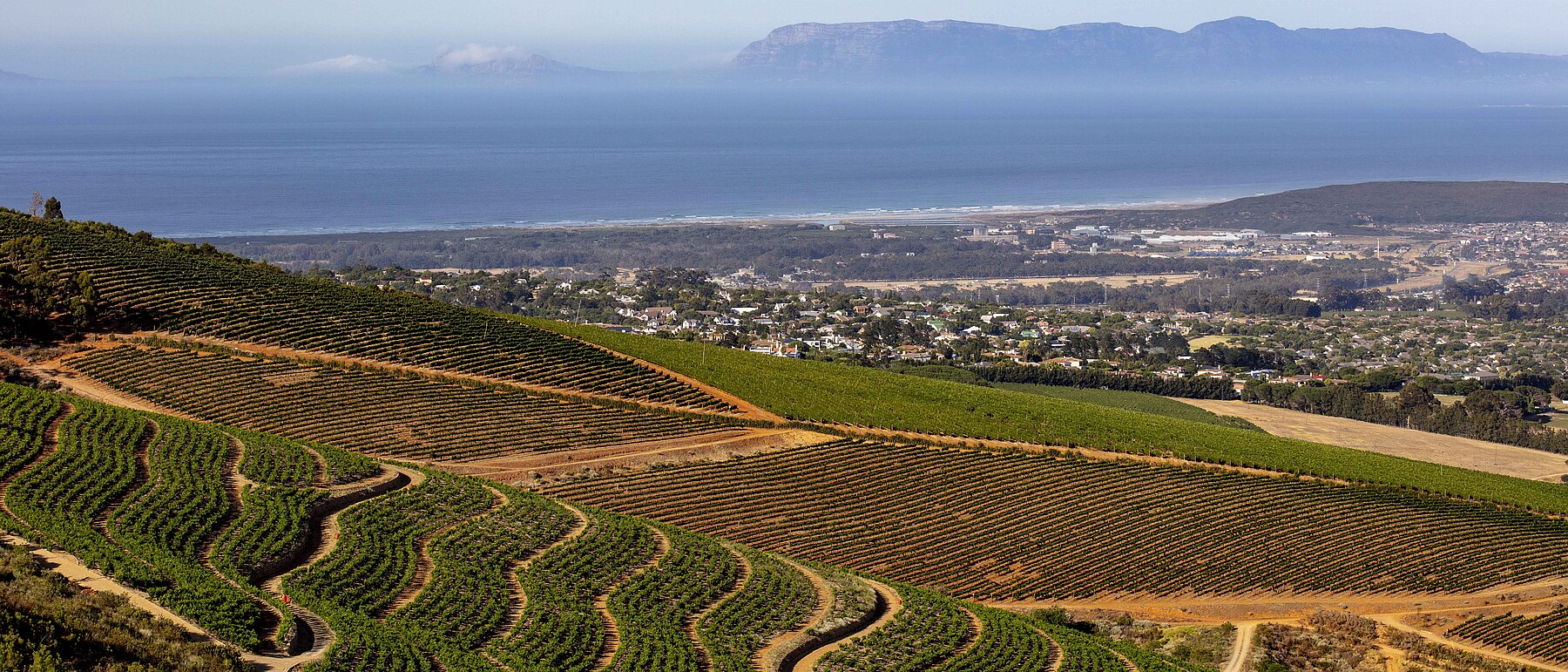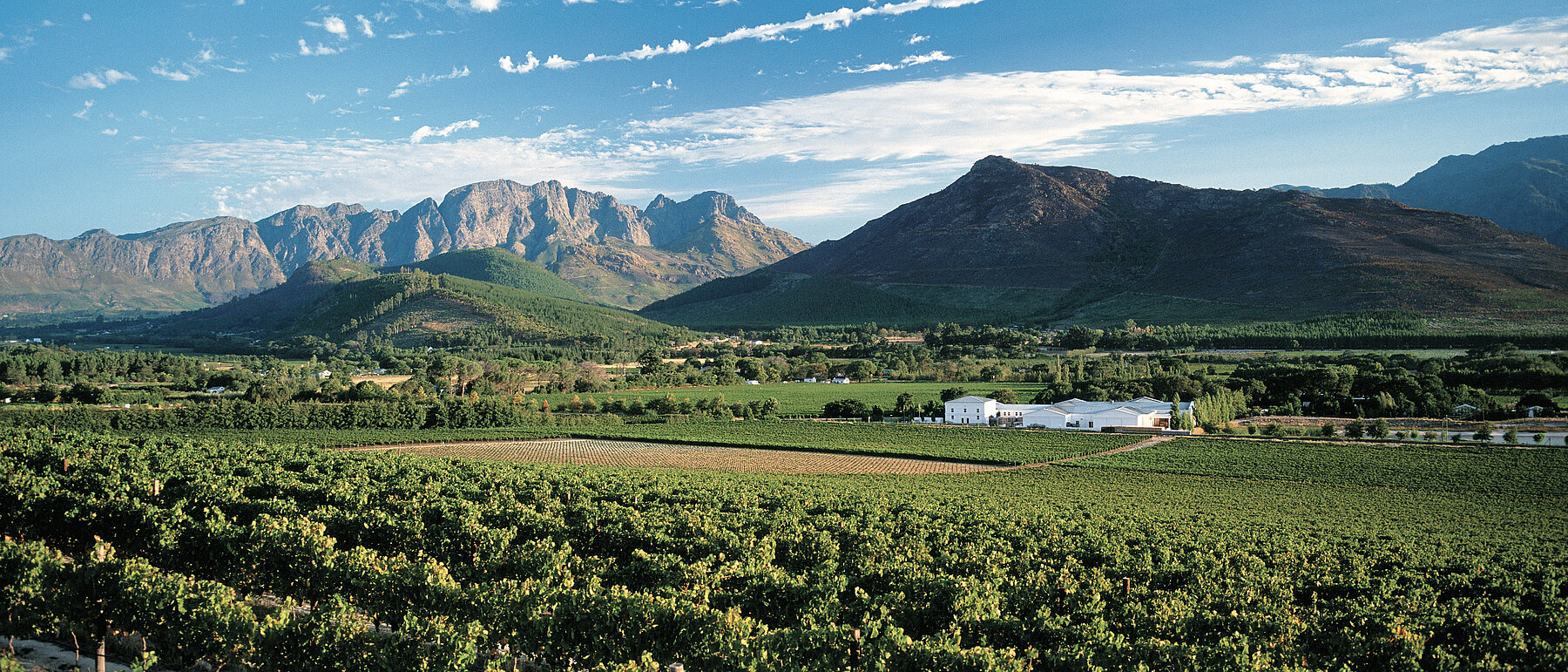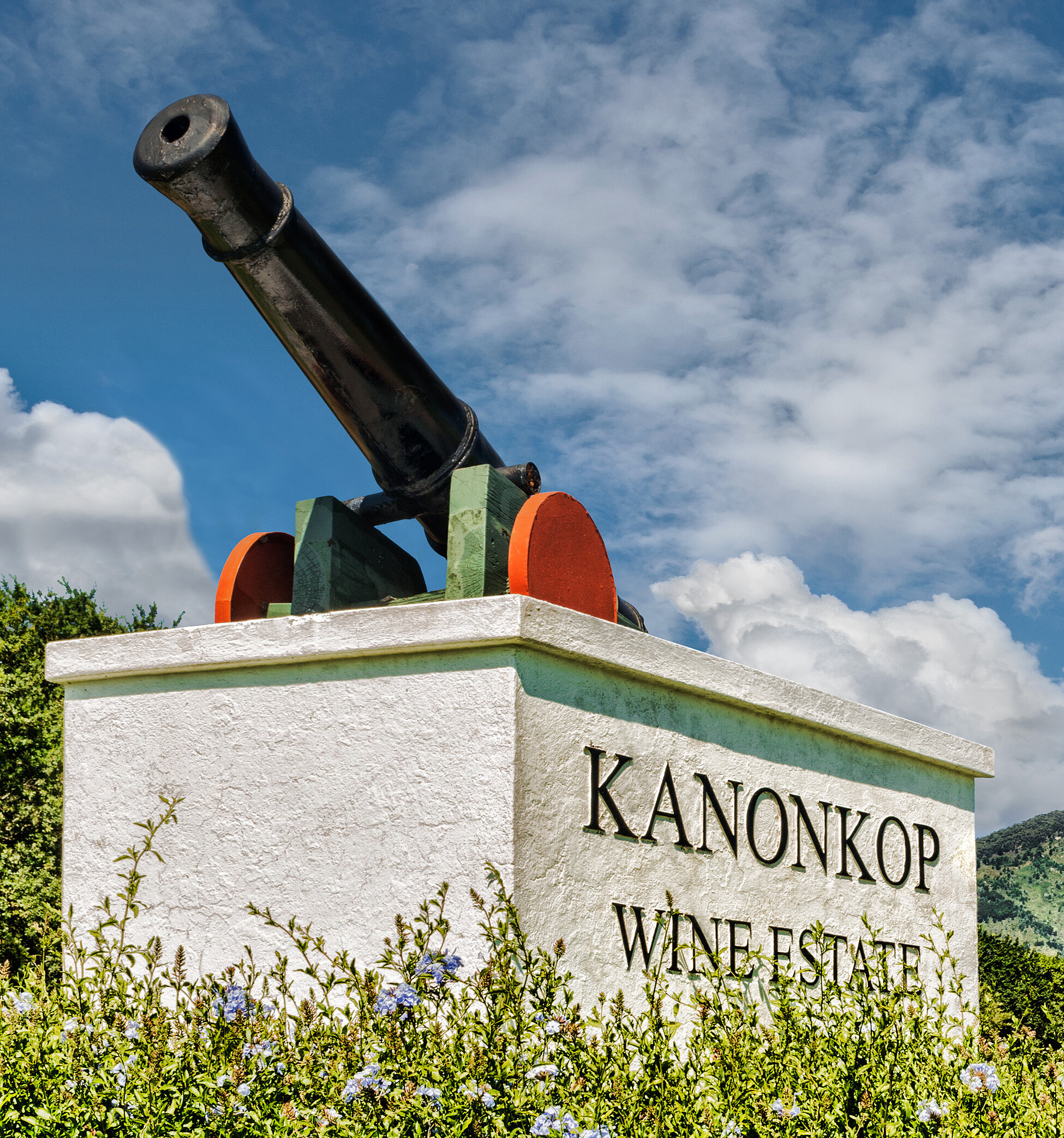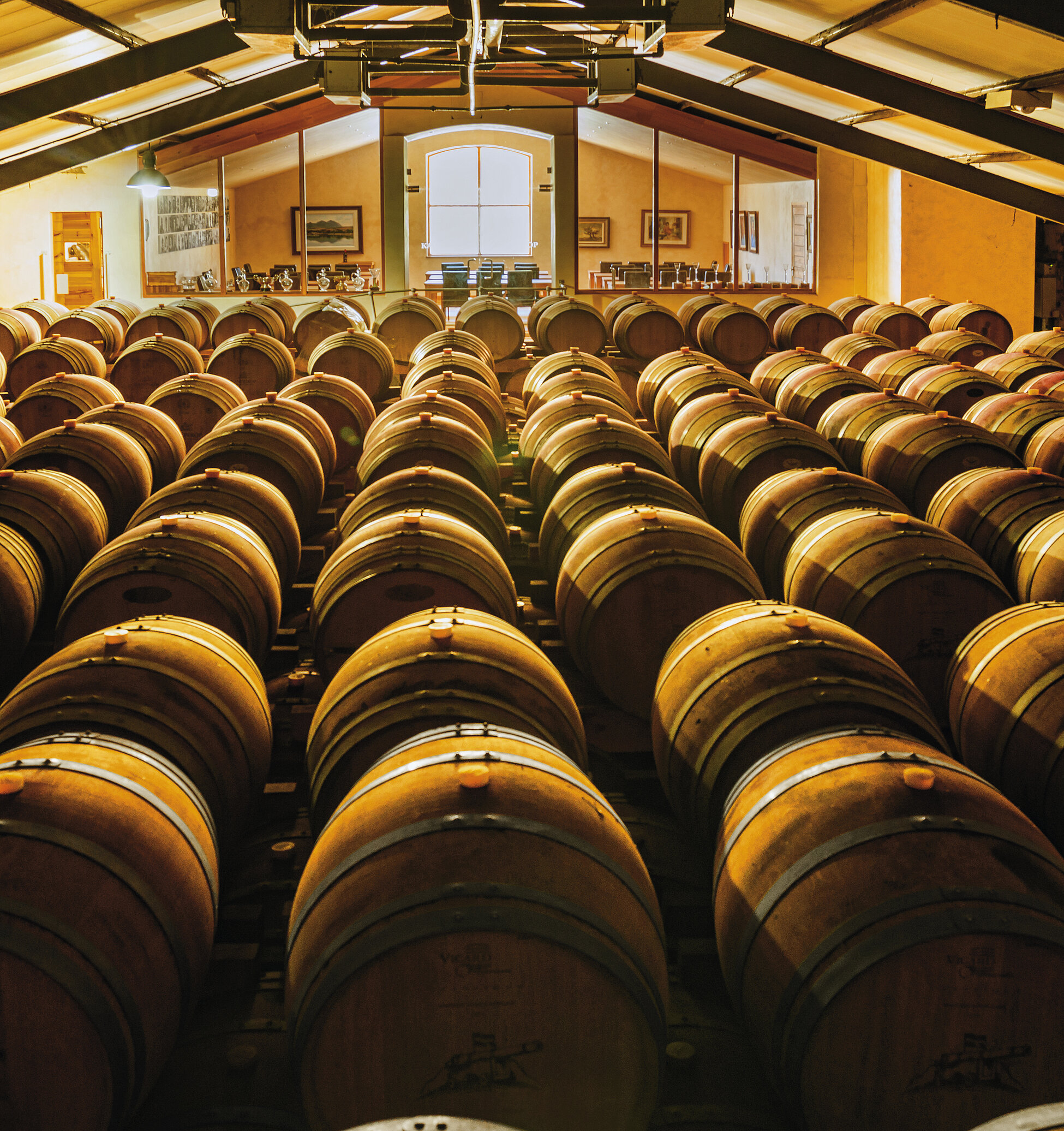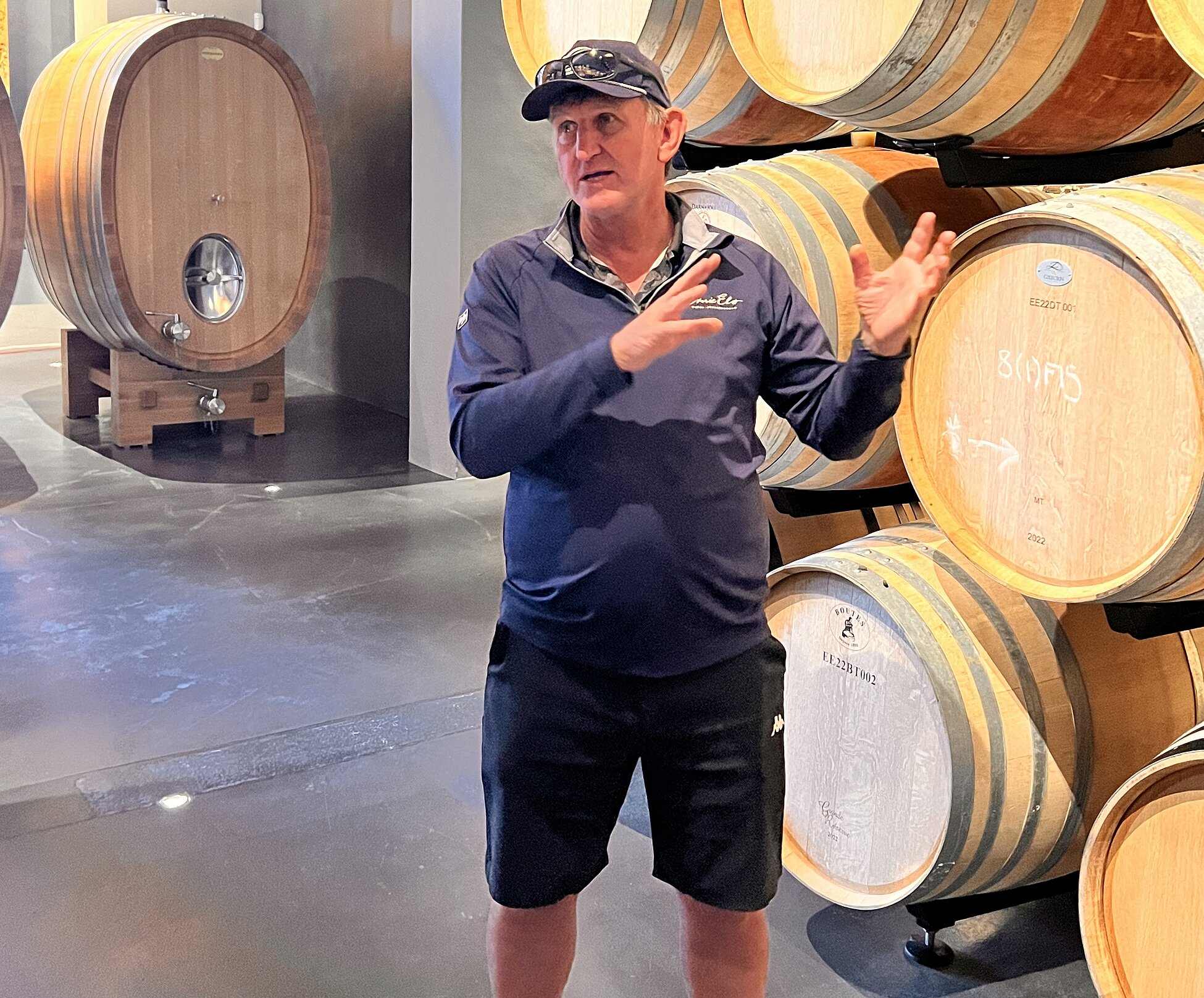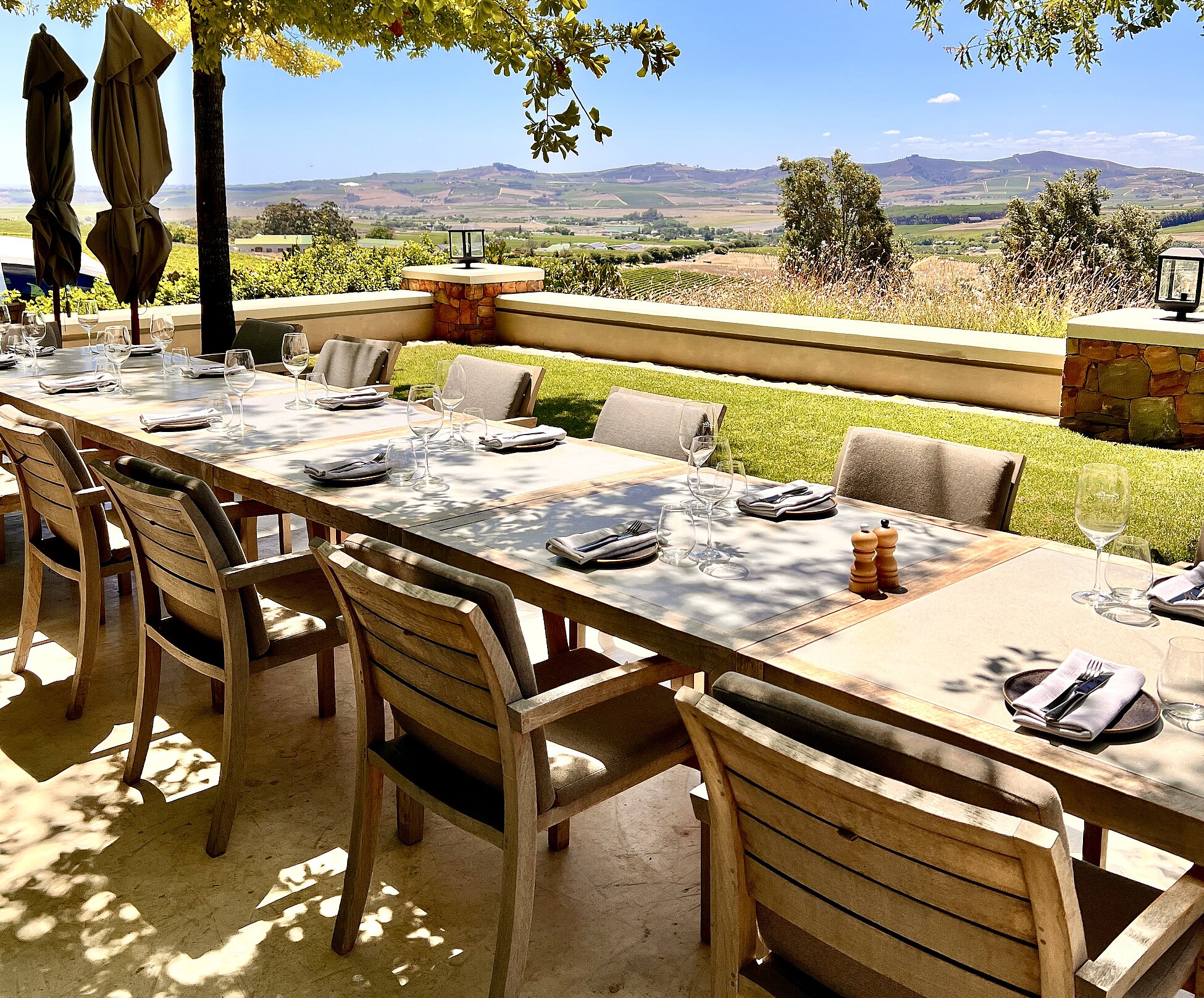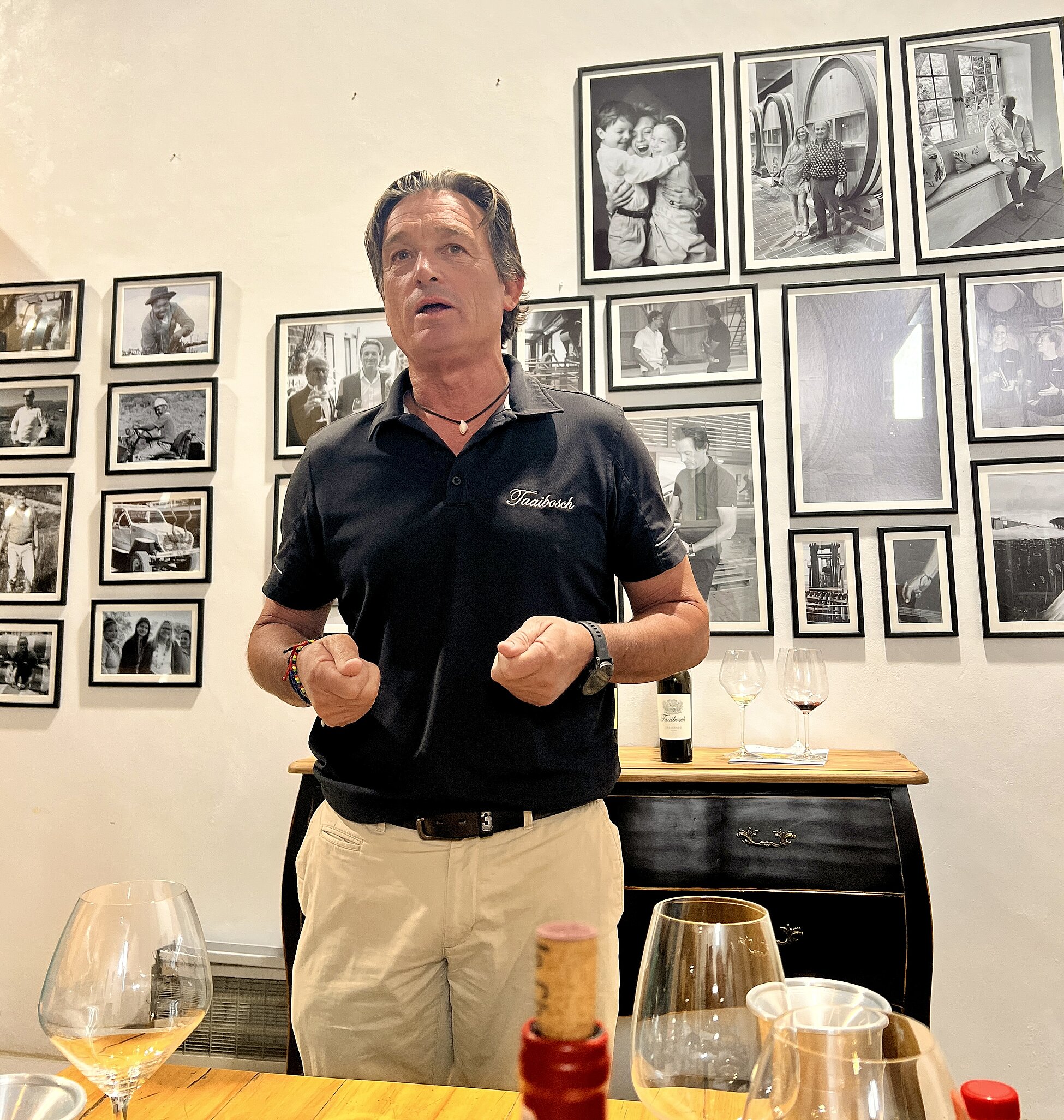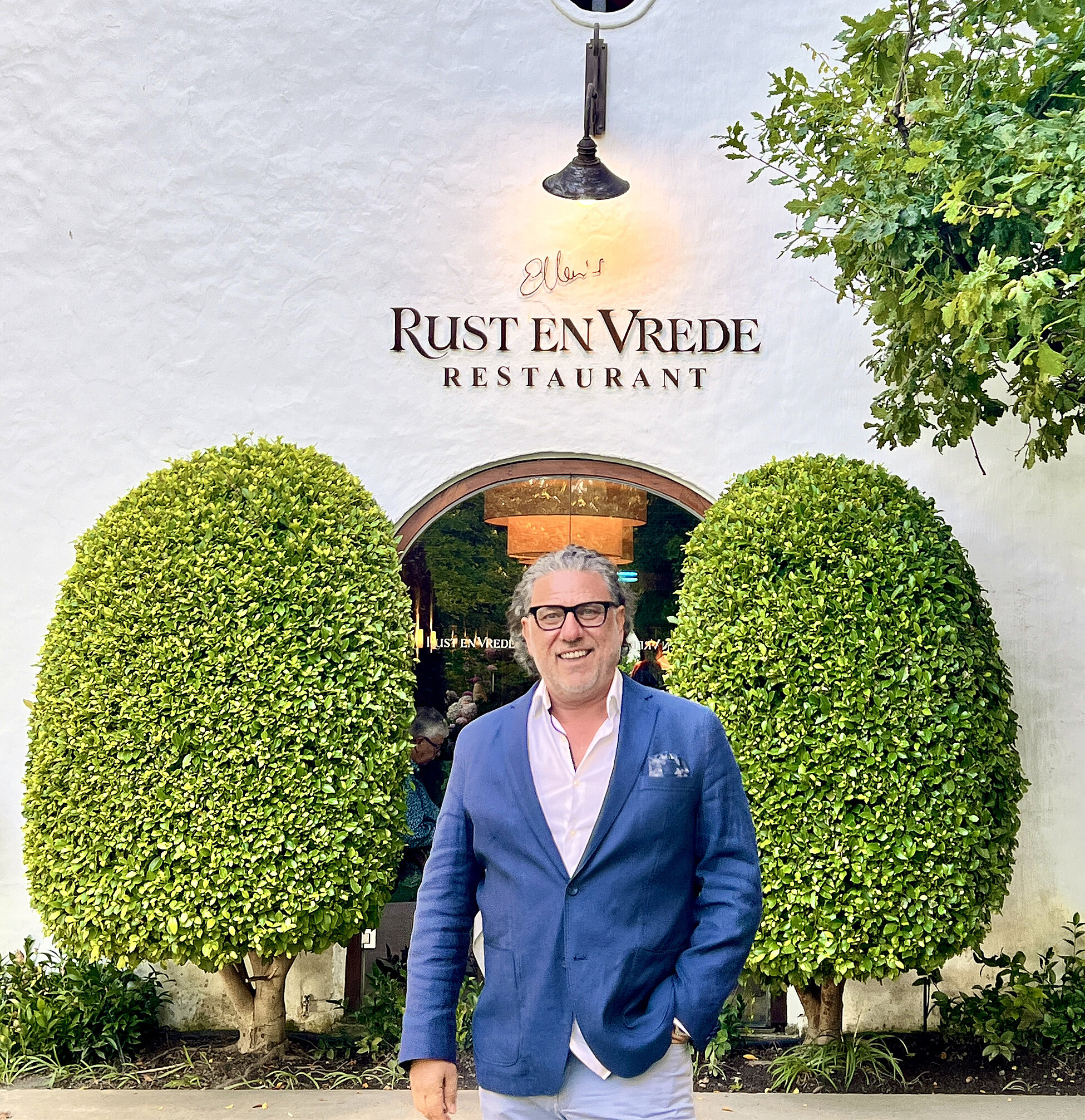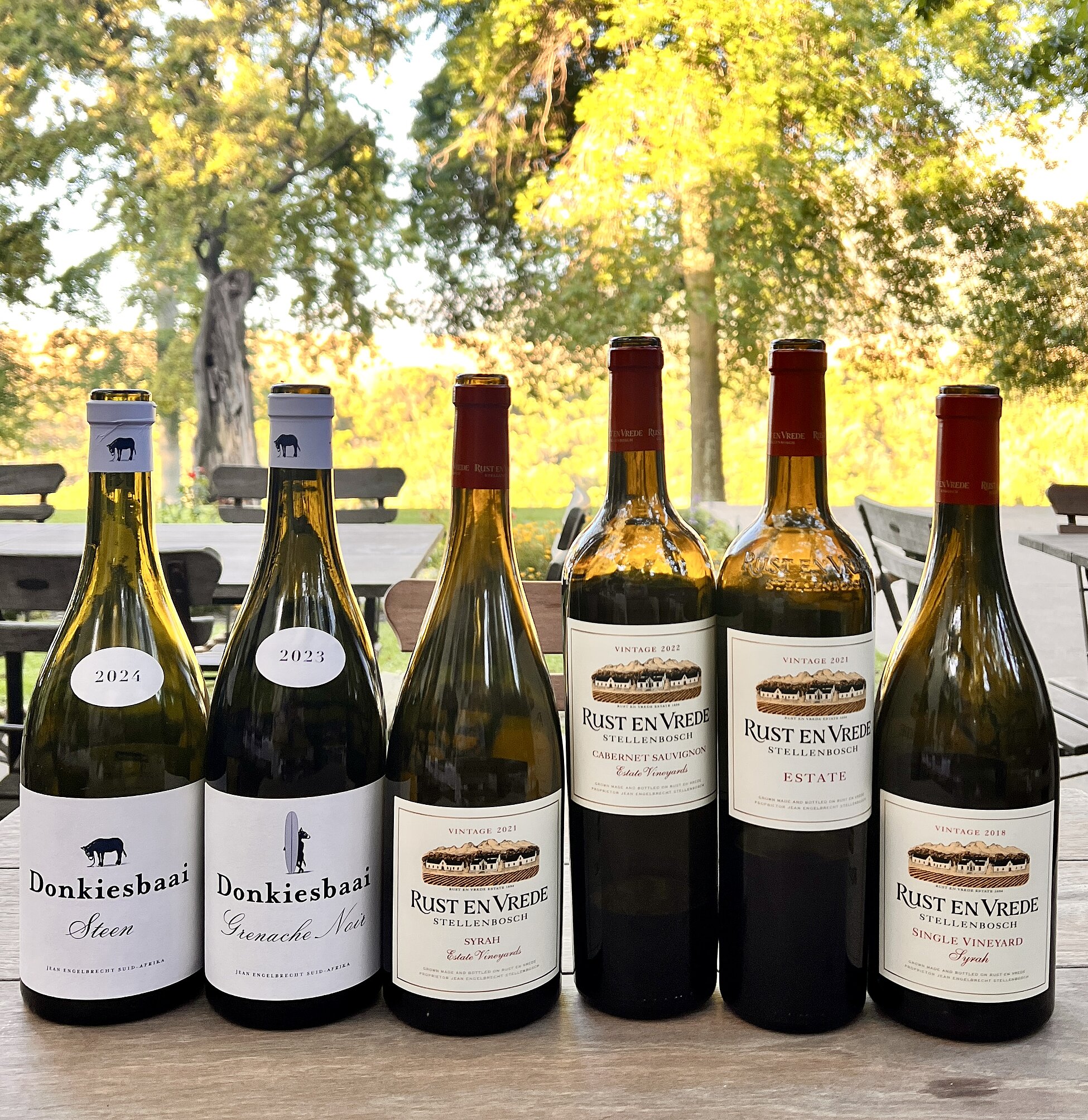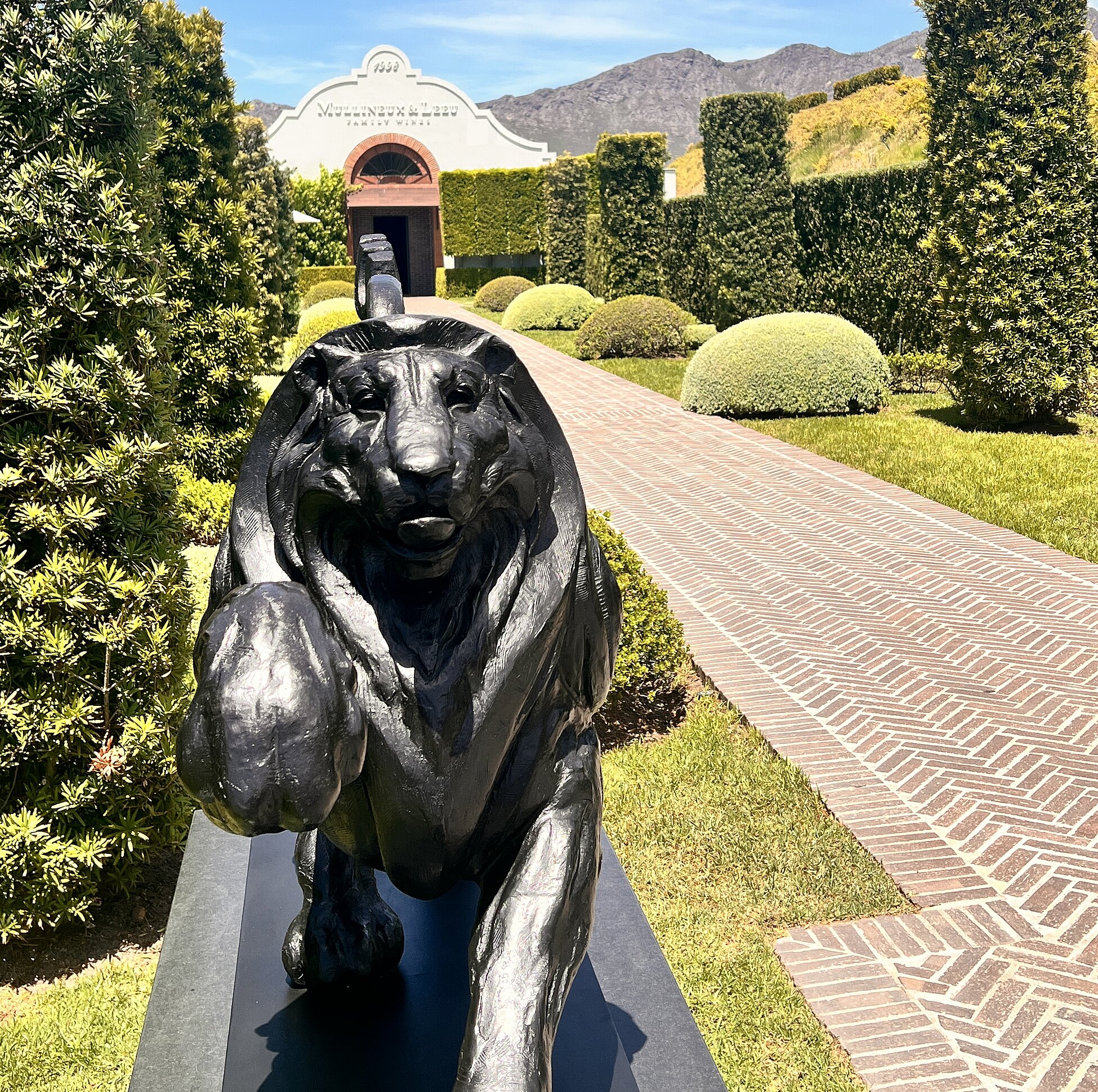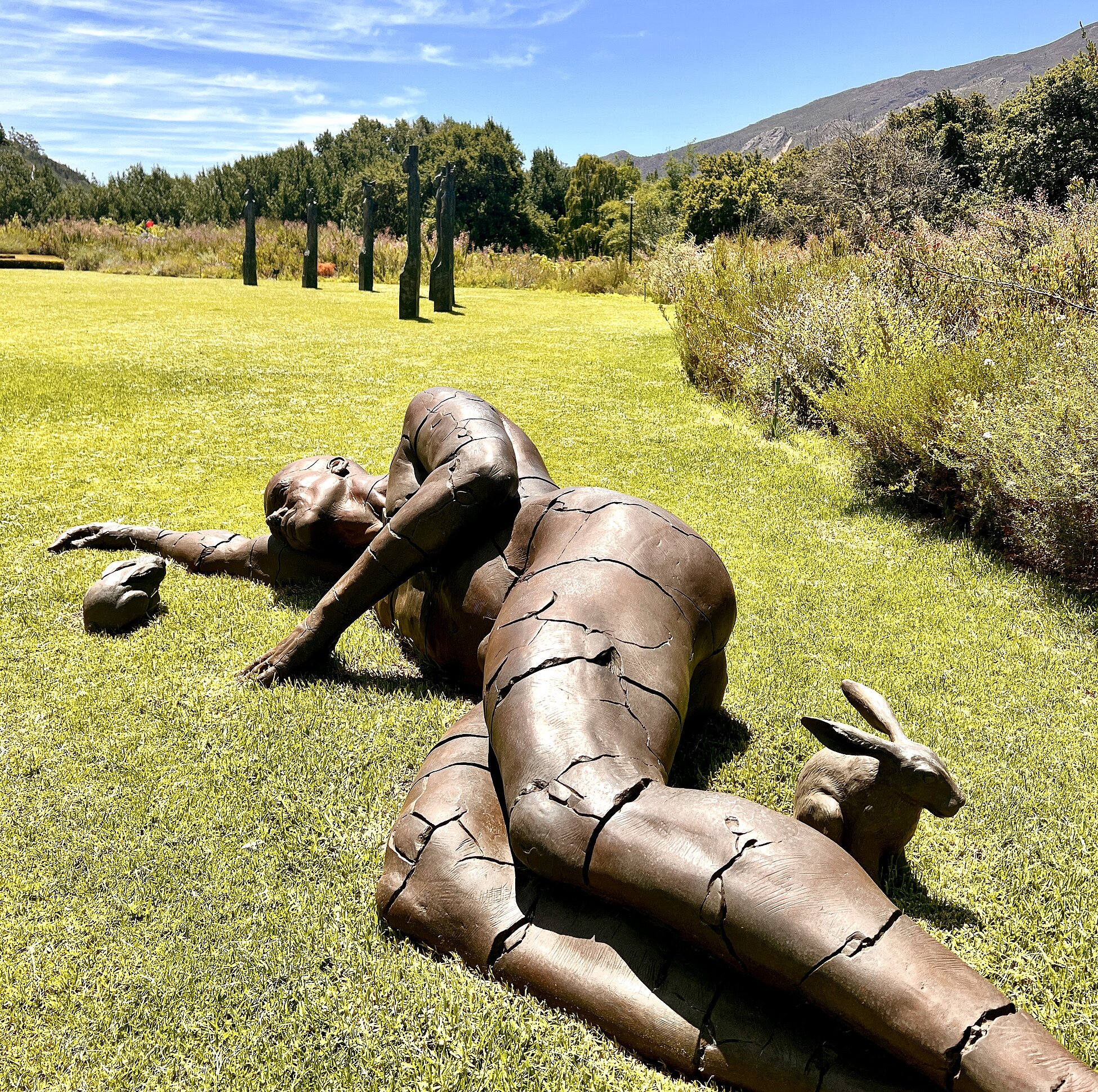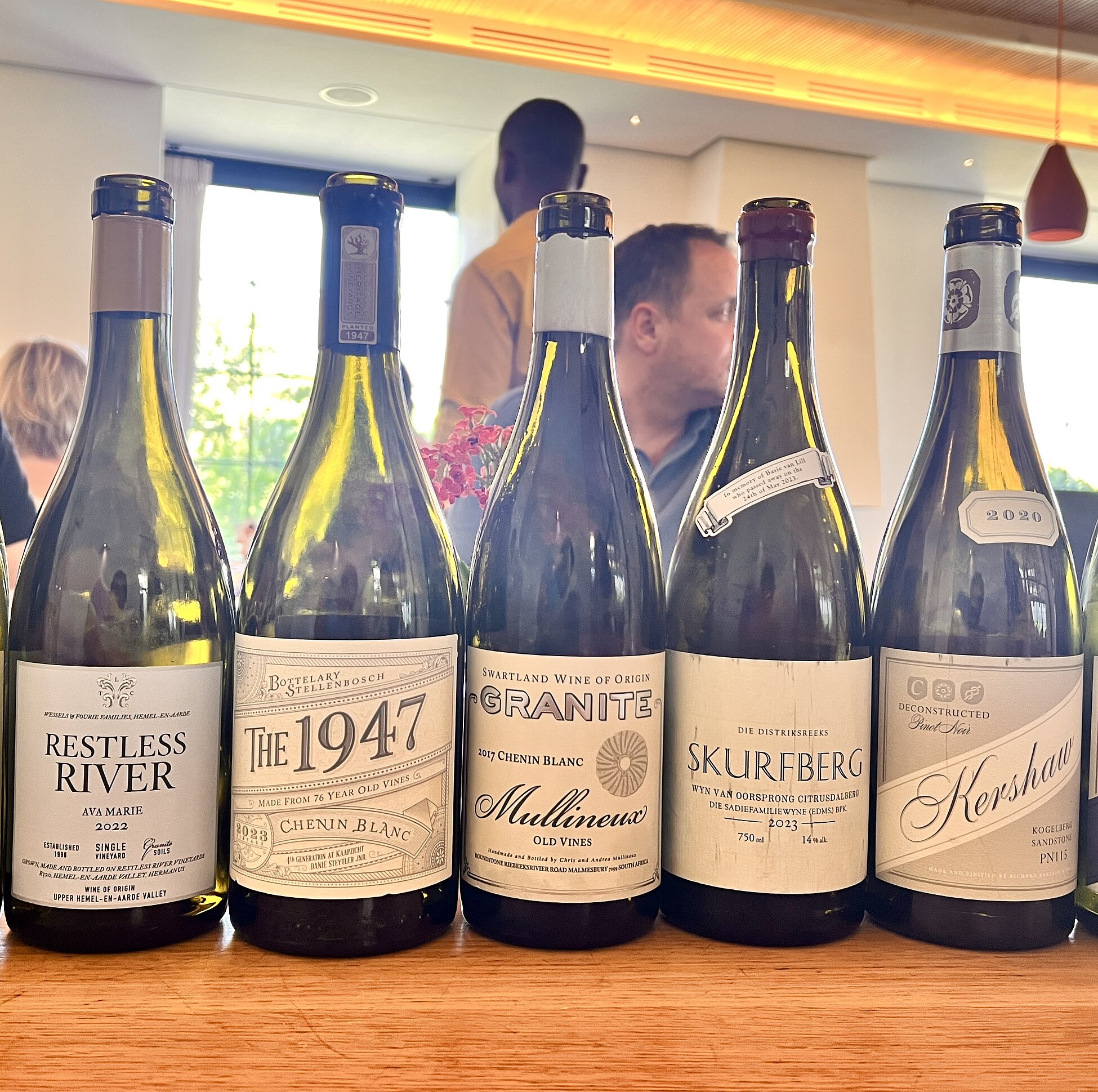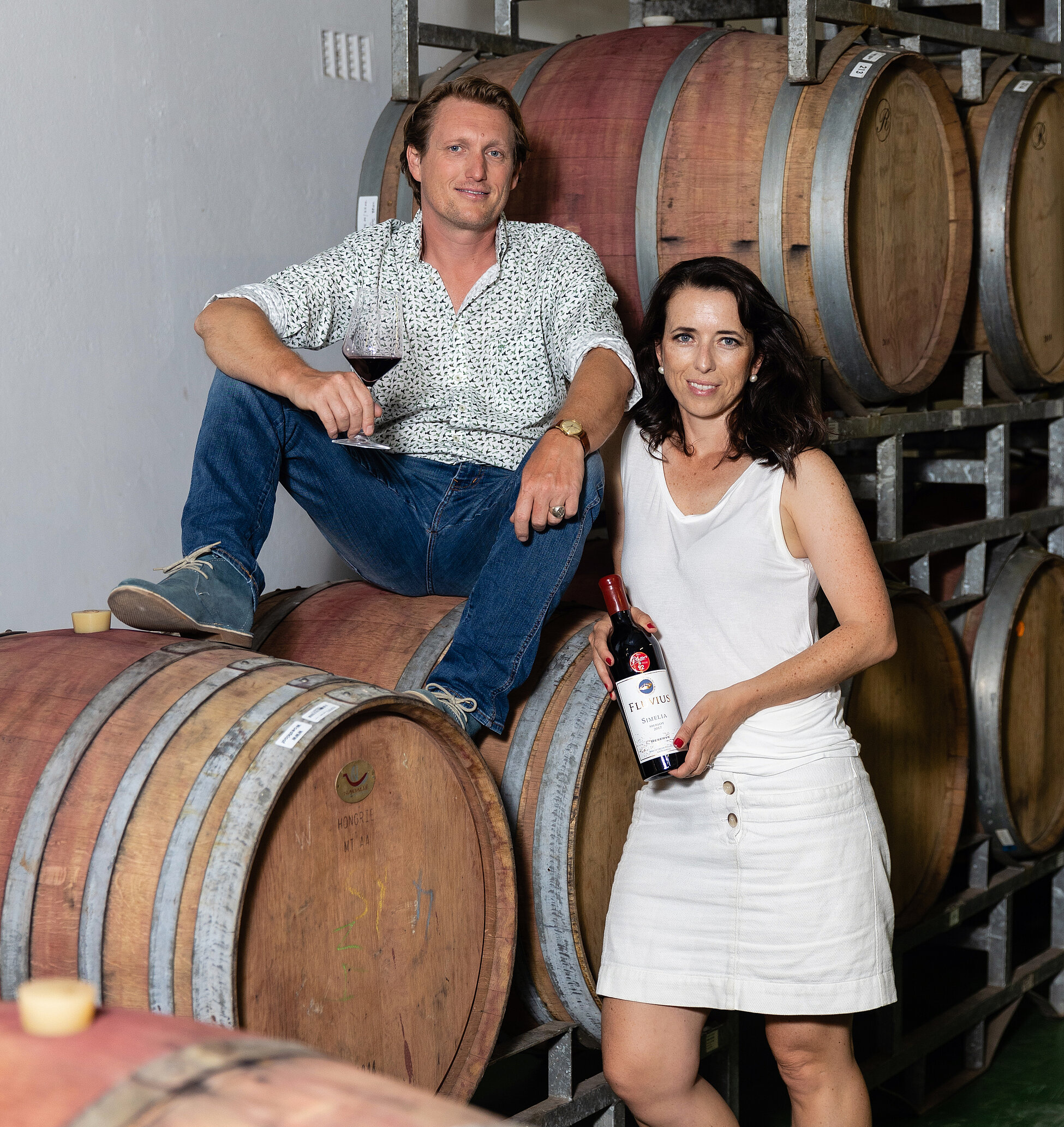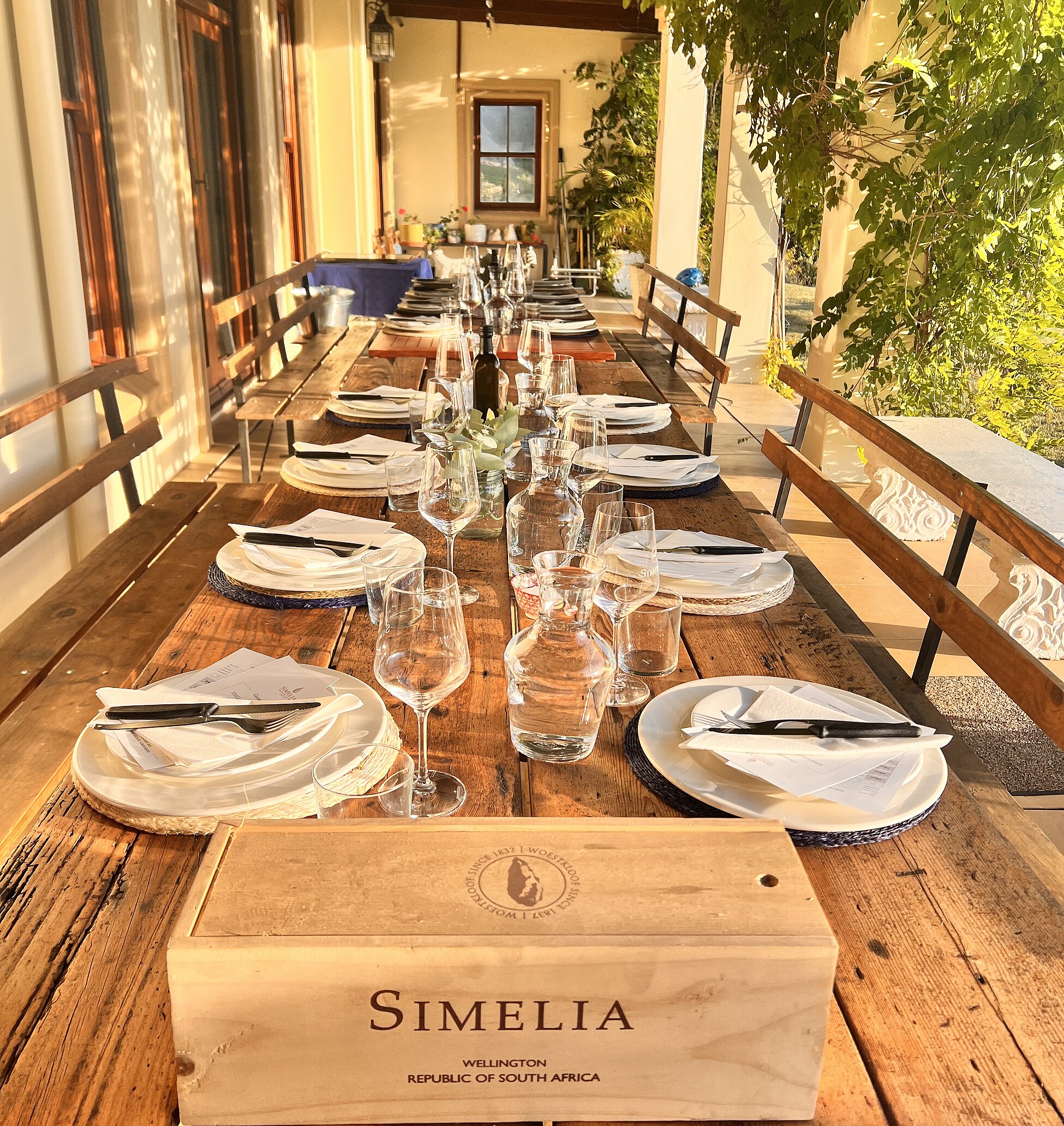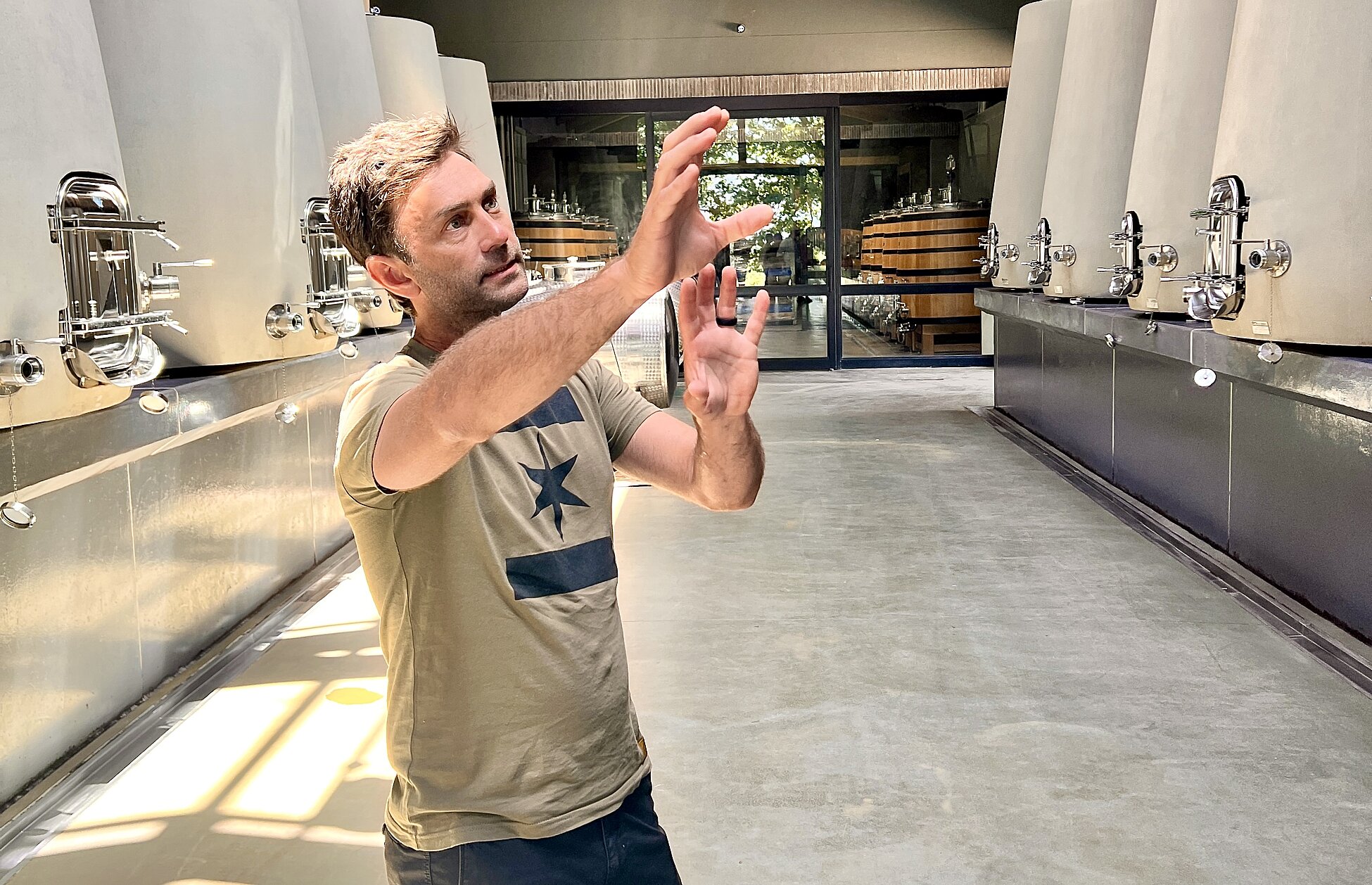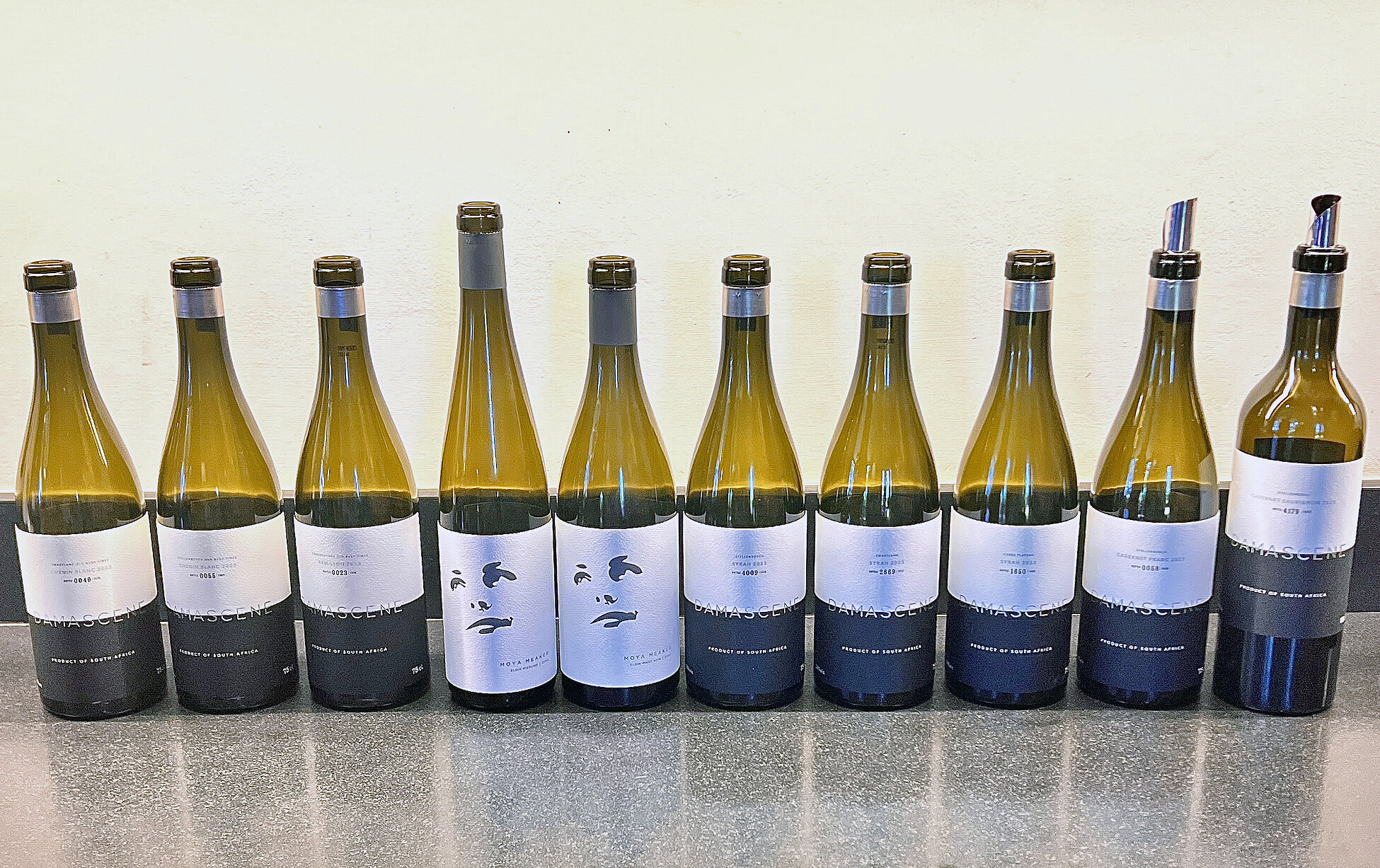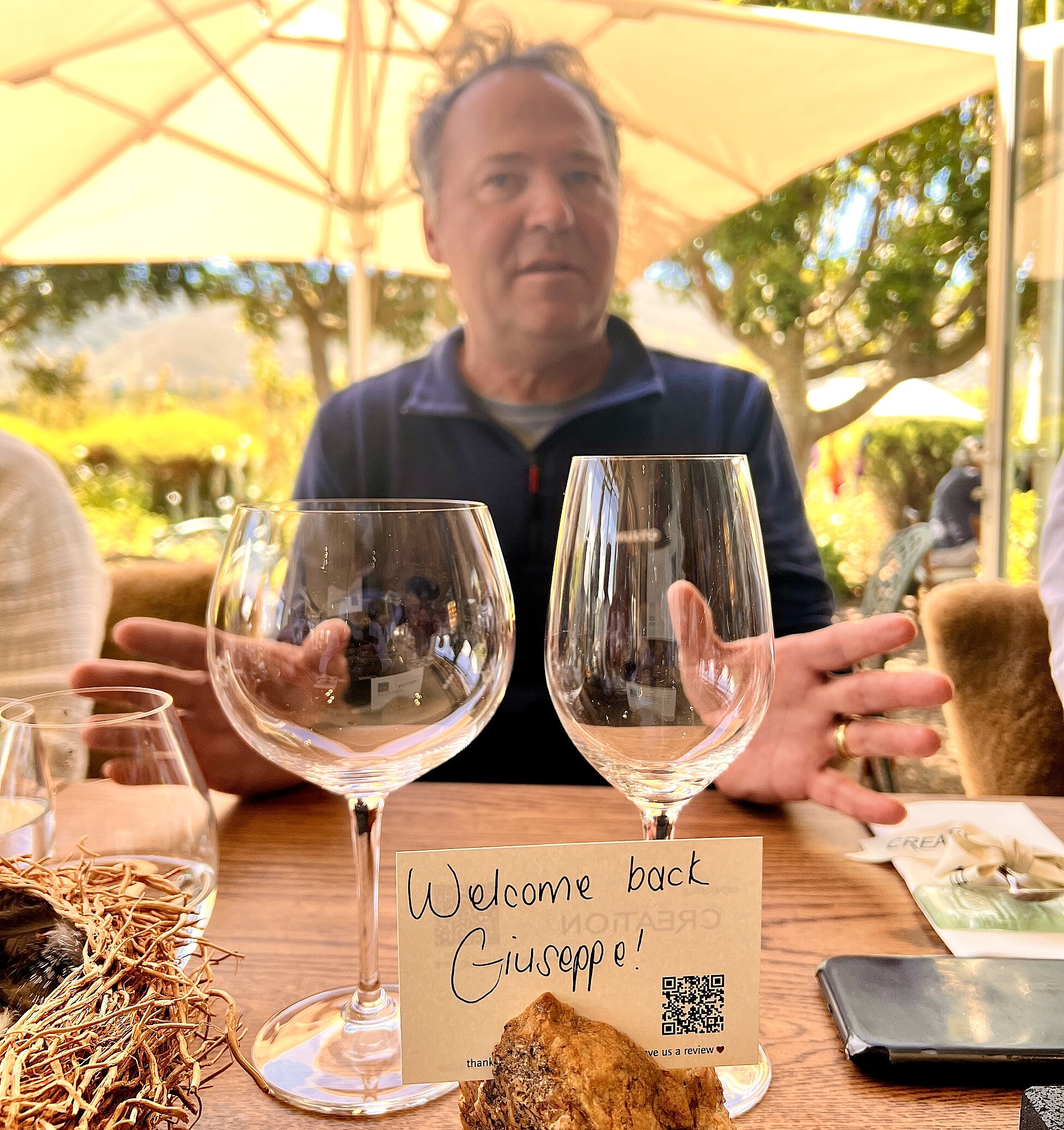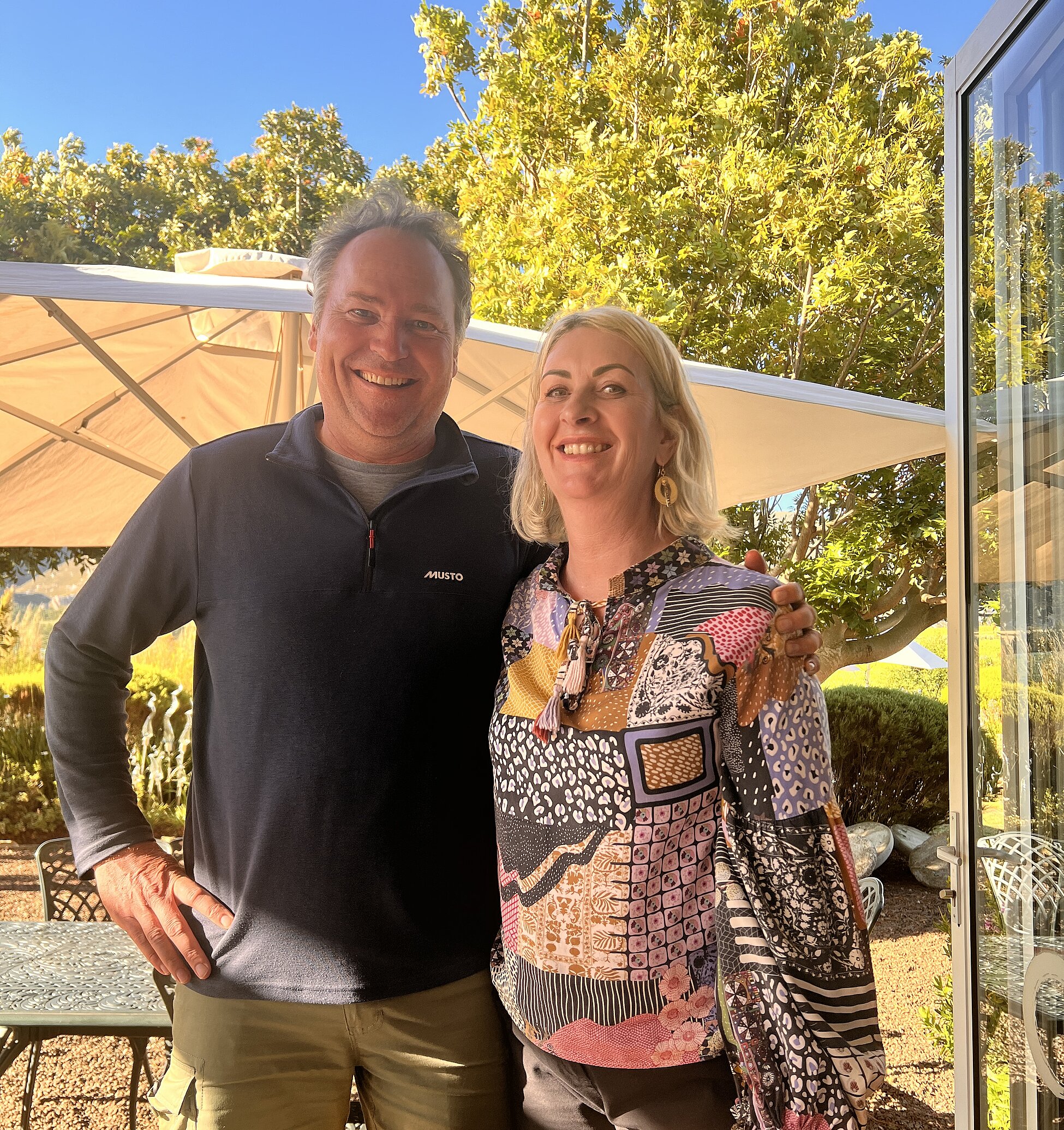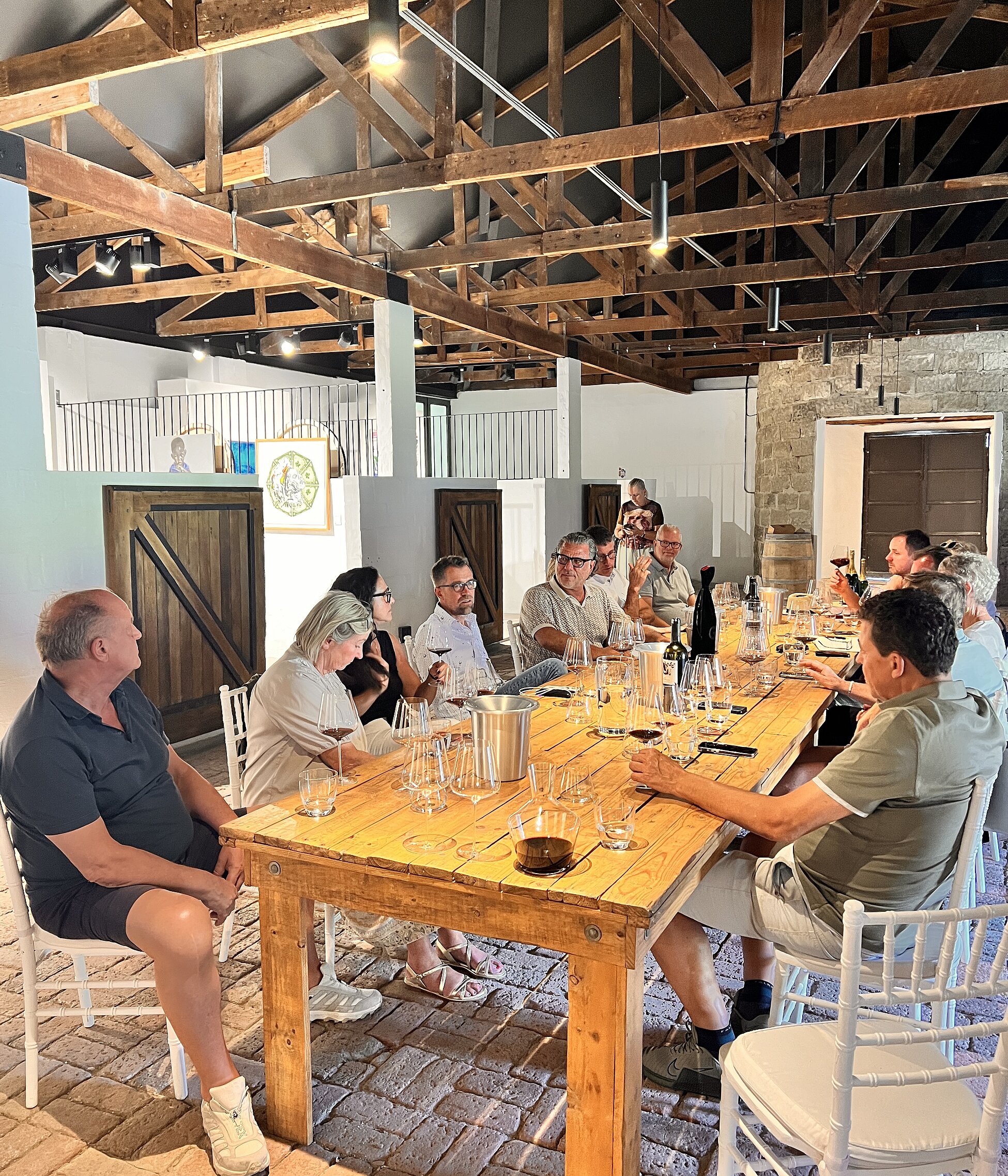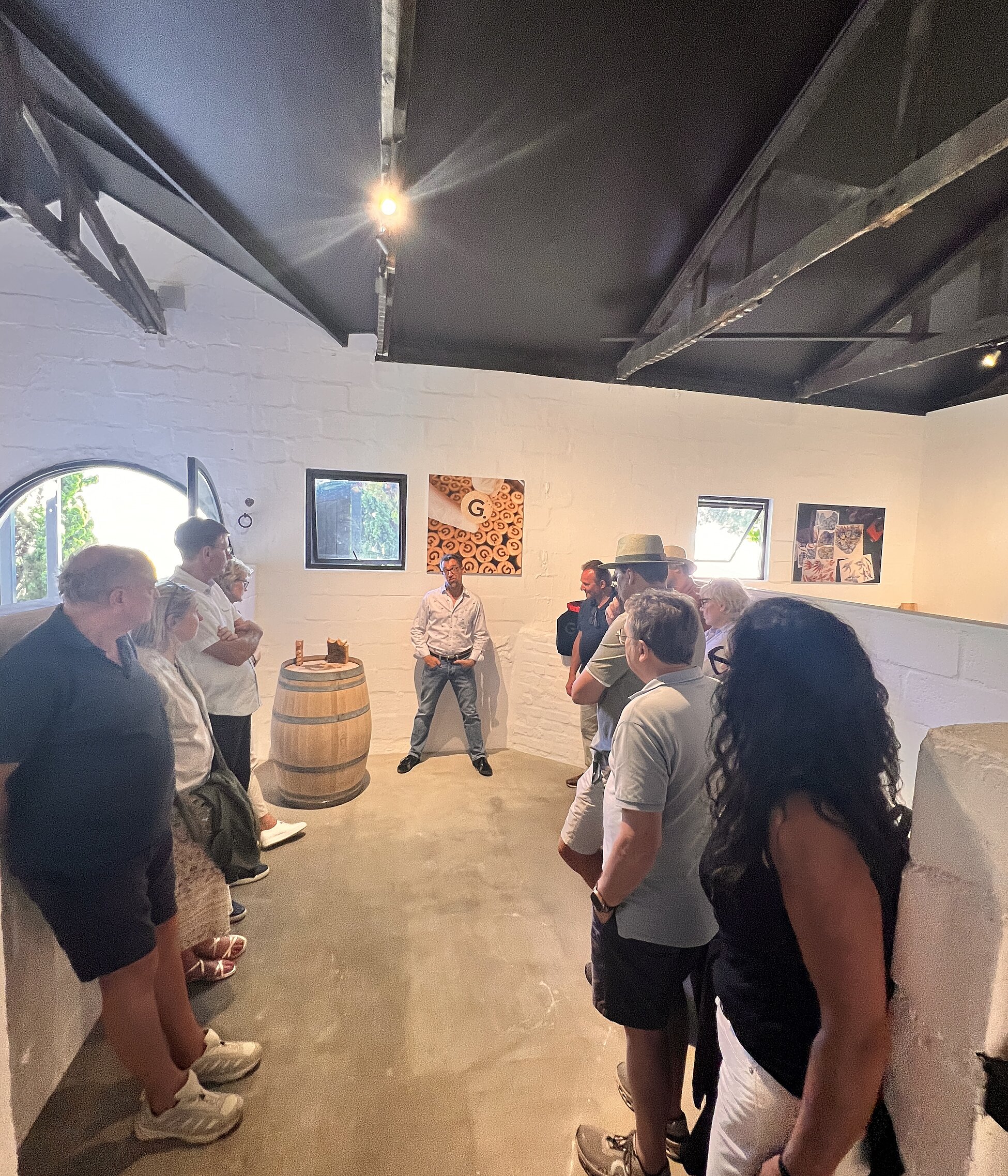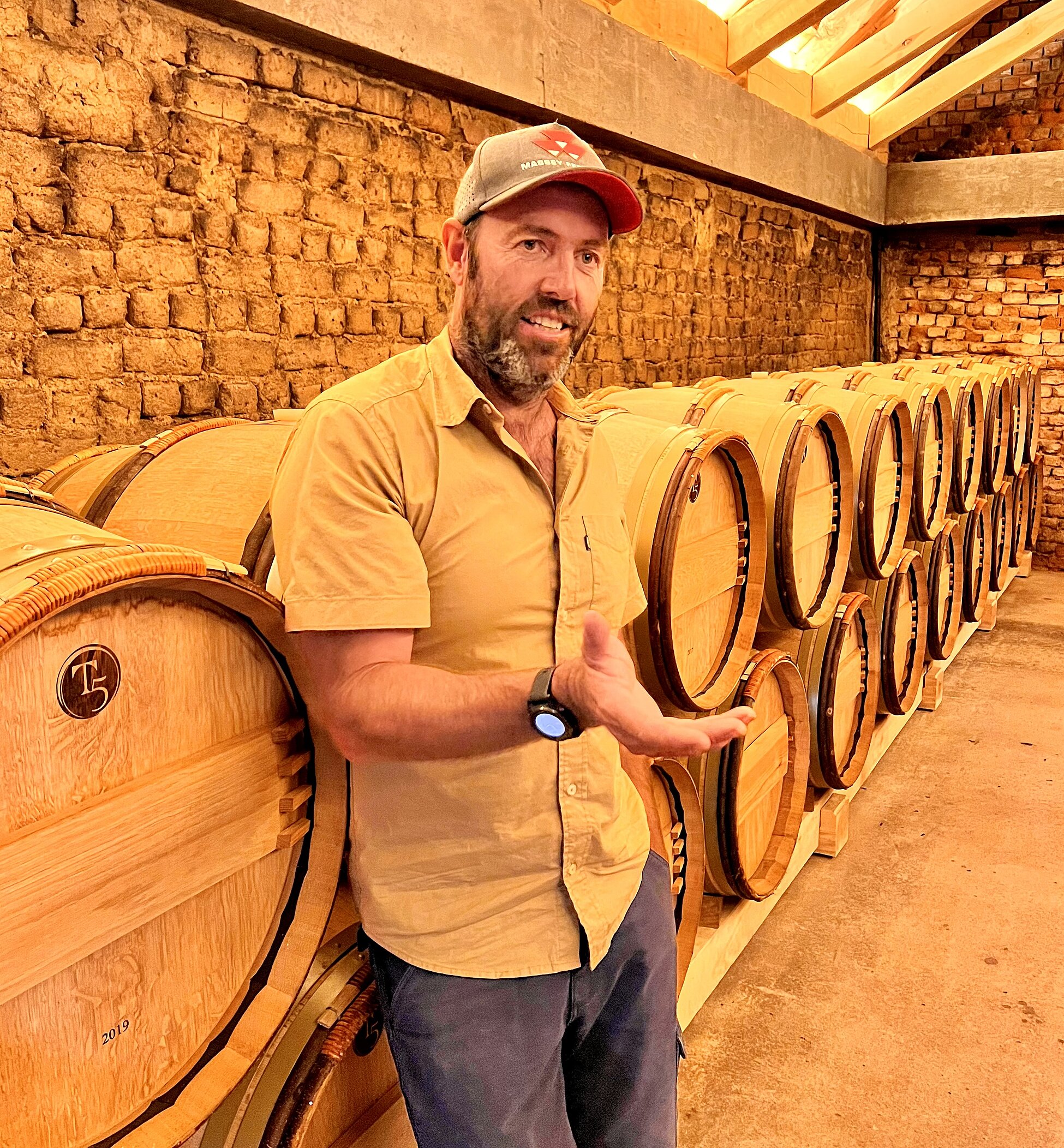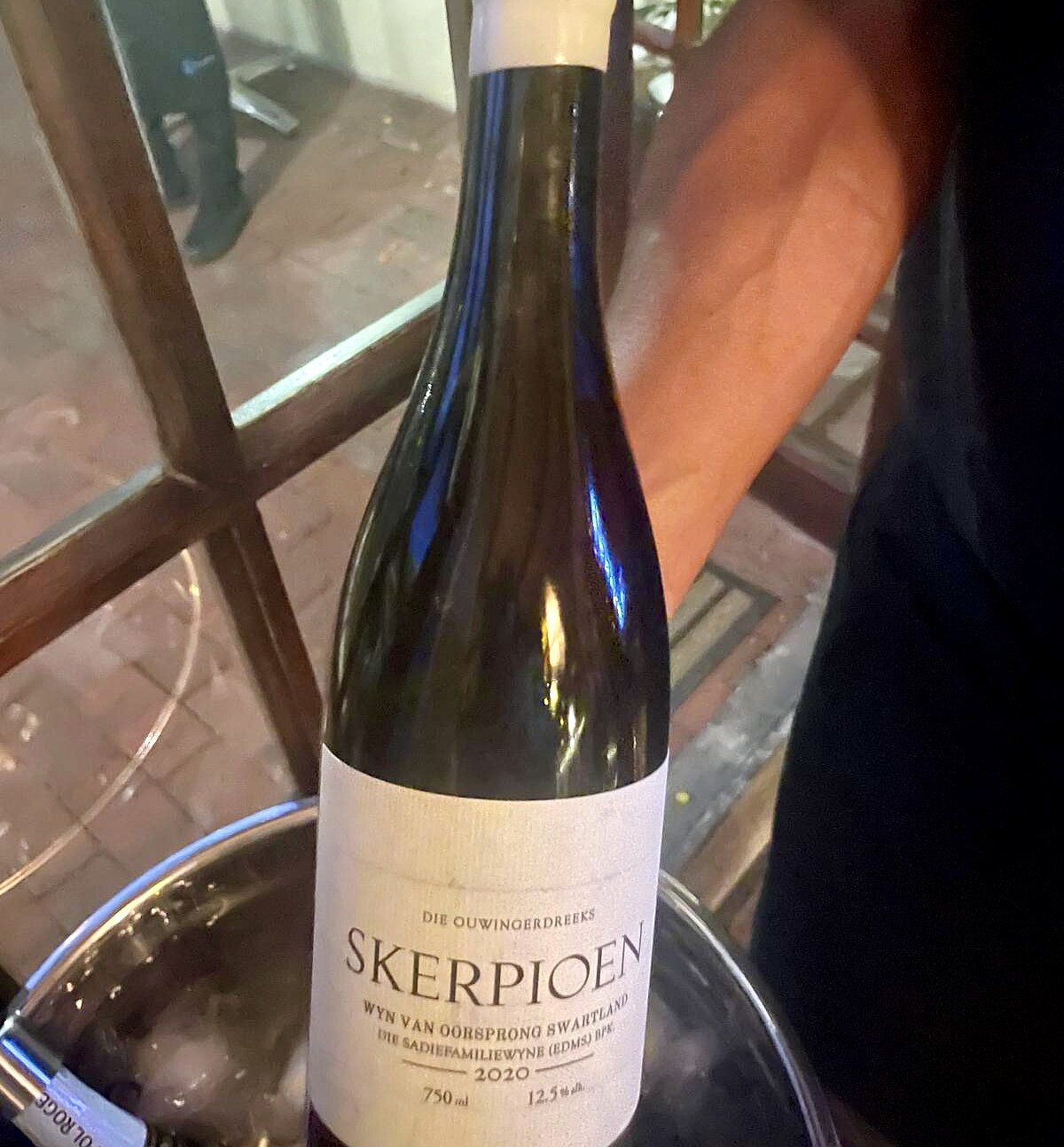New heights at the most beautiful end of the world
Hardly any other wine region in the world has experienced such a dynamic boom in the past decade as South Africa. The Cape region in particular is booming like never before. No wonder, as wine-loving visitors can expect impressive landscapes and a seemingly endless Garden of Eden of culinary delights. Editor-in-chief Giuseppe Lauria, who has been reviewing some of South Africa’s finest wines and restaurants for nearly a decade, once again travelled to the Cape of fine cuisine, meeting with leading winemakers and acclaimed restaurants, uncovering ambitious new wine projects, and reporting on a rising number of high-quality wines as well as an impressive array of world-class bottlings.
I have been traveling and reporting regularly on South Africa since 2017. In addition to the classic growing regions such as Stellenbosch, with icons such as Kanonkop, De Toren and 4G, Franschhoek (Mullineux, Boekenhoutsklof) and Constantia (Klein Constantia, Buitenverwachting), I also enjoy visiting the top winemakers in the less frequented Swartland (Eben Sadie, Davin & Nadia, Rall and many others) or in Wellington, where the German expatriate Simon Obholzer and his South African wife Celia Hoogenhout produce powerful Merlots and Syrahs on Simelia that are among the best in the country.
The cooler Hemel-en-Aarde valley above Hermanus, where prestigious estates such as Creation, Hamilton Russel, Newton Johnson and Restless River produce some of the country's best Pinots and Chardonnays, is also one of the flagship regions. Noteworthy estates such as Creation, Hamilton Russell, Newton Johnson, and Restless River produce some of the country’s finest Pinots and Chardonnays.
The “young mavericks” of the “Zoo Cru” collective — including Chris Alheit, Peter Allan Finlayson, Duncan Savage, and Jocelyn Hogan — are also among the nation’s best.
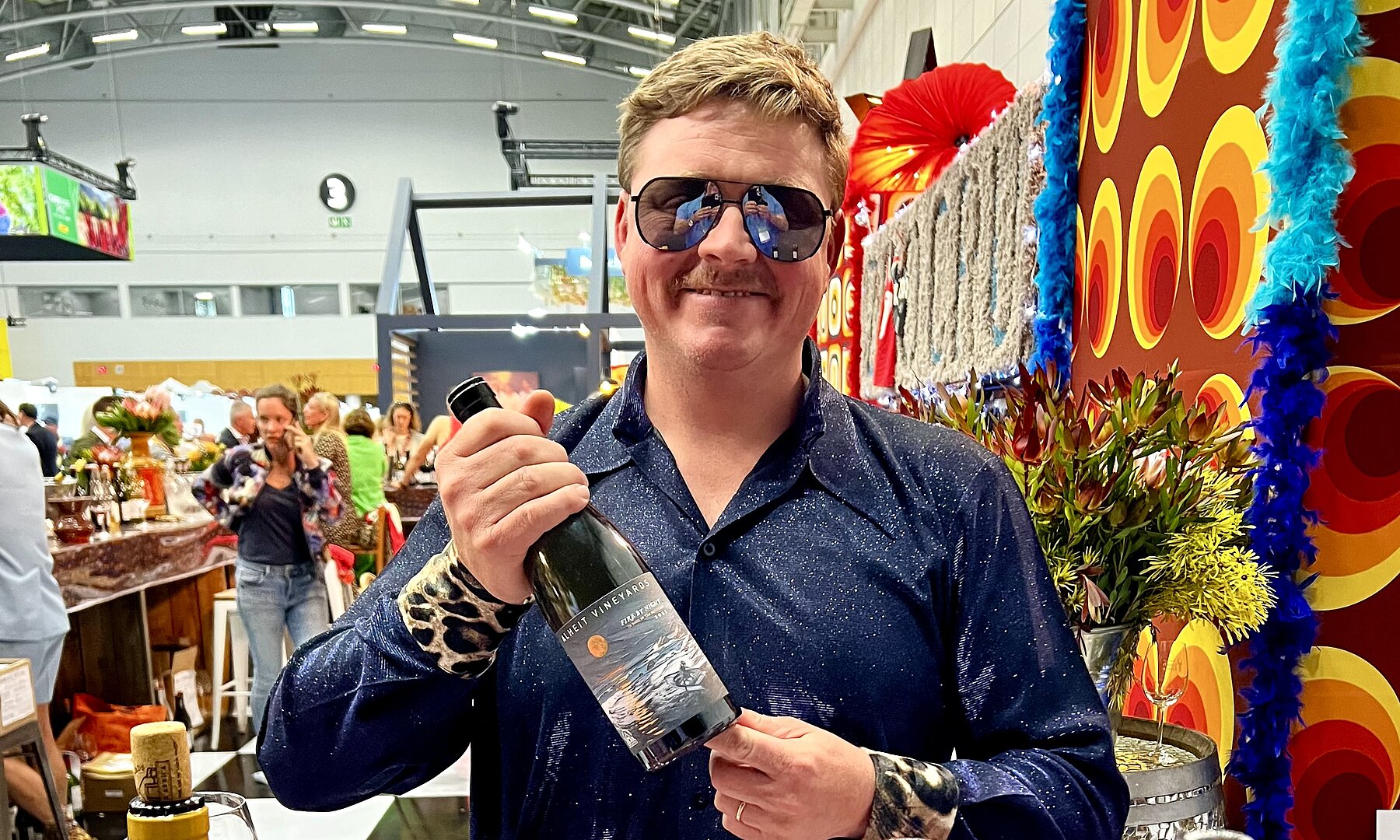
It’s colorful and loud at the Zoo Cru stand with Chris Alheit – as it was here during the Capewine.
Paradise for gourmets and wine connoisseurs
The Cape Winelands is truly a paradise for gourmets and wine connoisseurs and is one of the most beautiful places in the world. The dense offer of high-quality restaurants and wineries worth visiting in the Cape is simply unique. Every year we get to experience this anew on my exclusive wine and gourmet tours.
Breathtaking landscapes, unspoiled nature, top wineries with picturesque charm and a huge range of ambitious gastronomy. Often all in one place, because the wineries are a great place to taste, linger and enjoy fantastic food. And before the next wine trip in January 2026, we like to reminisce.
Cape Town - a culinary melting pot of three continents
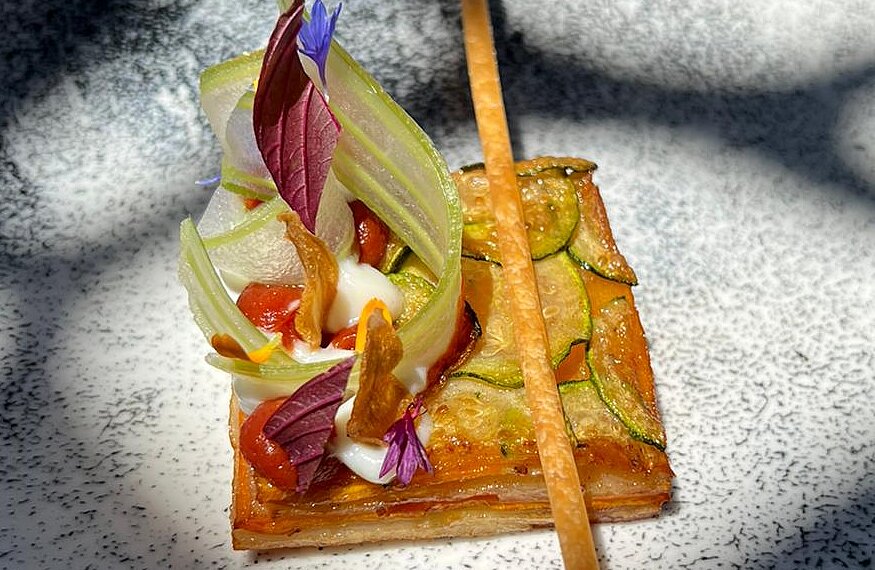
South African cuisine is incredibly varied and always exciting.
Cape Town was recently crowned the most liveable city in the world. This was the result of a survey by Time Out magazine.
No wonder - the coastal city is incredibly diverse and worth living in, as well as being a melting pot of cultures, which is also reflected in the culinary aspects of Cape Malay fusion cuisine. After all, immigrants from Asia (India and Malaysia) and Europe brought their very own spices and recipes with them.
This makes this cuisine incredibly varied and always exciting. A naturally evolved fusion cuisine, if you will. The culinary voyage of discovery to the Cape of Good Hope is a colorful and sensual experience. And anyone who has ever marveled at the most beautiful end of the world from the top of Table Mountain or Lions Head will want to return anyway.
Opening Dinner at Aubergine
The gourmet restaurant Aubergine in Gardens, run by the German Harald Bresselschmidt for more than 25 years, is also highly recommended (3rd place in my ranking of the best restaurants in WW 03/22). The welcome dinner for our culinary wine tour regularly takes place here. The maître is an experienced top chef, wine lover and has a well-stocked wine cellar. He also regularly organizes high-quality tasting events under the motto "Auslese". His classic gourmet cuisine is skillfully fused with Indian-Malay accents, and the wine list is one of the best in South Africa.
One of his signature dishes, such as the classically reduced lobster bisque, as well as his super tender springbok, also had us raving this year. We have already spent so many legendary evenings here - a true feel-good place with the highest culinary standards. This year, our "culinary gang" was once again impressed by the excellent menu and the exciting wines. The focus was on the popular Swartland and some new names.
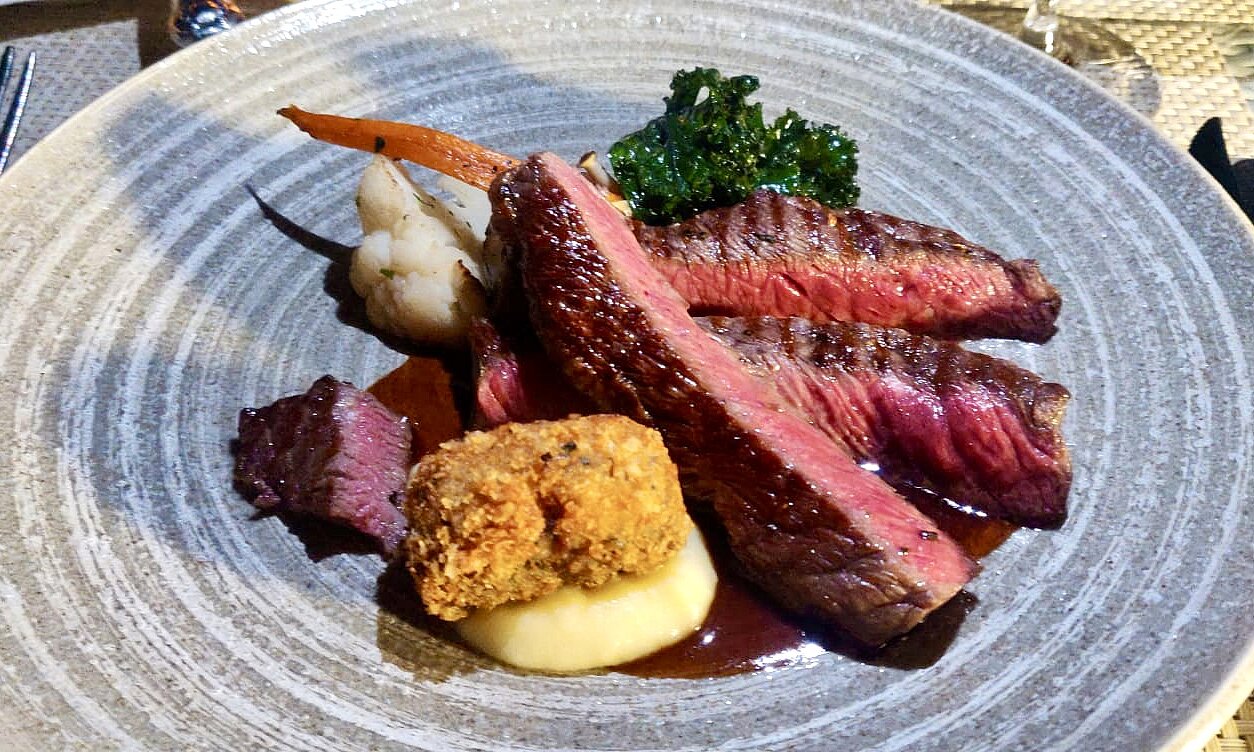
At Aubergine, run by the German Harald Bresselschmidt, you dine at the very highest level.
A stone's throw away from Cape Town are South Africa's best-known wine-growing regions, which shine in new splendor with their picturesque Cape Dutch-style wine estates.
News from Stellenbosch
Sophisticated Stellenbosch is considered the Bordeaux of the South African wine regions. Here, one noble wine estate is lined up next to the other. First and foremost is the Delaire Graff wine estate, which is somewhat reminiscent of Hollywood and belongs to the gold trader and multi-billionaire Graff. While the wines are incomprehensibly rather mediocre, the estate is absolutely worth seeing, adorned with sculptures and peppered with expensive art. The estate has two restaurants, an upscale bistro and the gourmet restaurant Indochine, which offers classic Cape Malay fusion cuisine but has rarely been at the top of our list of best restaurants. The lively student town itself is also worth a visit: whitewashed avenues of houses in Cape Dutch style, many boutiques, art galleries and a distinctive bistro and bar scene invite you to linger.
After checking into our 5-star hotel, which itself houses a winery and is located in the middle of the vineyards with spectacular views of the hotel's own pond and the Stellenbosch mountains, we headed straight to the Glenelly winery, 20 minutes away.
This is characterized not only by its ingenious location and the variety of its wines, but also by its famous owner Madame May Lenquesaing, the former owner of the Bordeaux icon Pichon Comtesse. She bought the estate in 2003 at the age of 78. Here we enjoyed a very exciting wine tasting and a delicious lunch with a view of the surrounding vineyards. The comparison of the two Chardonnays (Oaked / Unoaked) and the vintage comparison of the flagship red wine were particularly enlightening (see notes). A chilled-out place to arrive and enjoy.
In the evening, we went to Stellenbosch to the trendy Post & Pepper, which impressed us with its ambitious "spicy" fusion cuisine in a casual bistro style. The raw marinated tuna in ponzu sauce was outstanding.
The next day, the weather was glorious as we headed to Ernie Els' vineyard, which is well worth a visit. He was once the best golfer in the world and has built an architecturally spectacular winery there. Here we met Head Winemaker Louis Strydom, who took a lot of time to show us around and take some mature wines out of the cellar. We also enjoyed the restaurant with its fabulous view.
Not far from Ernie Els Winery is the relatively young Taaibosch winery, which was acquired by the Oddo family in 2016. The vines for the exceptional red wine "The Crescendo" grow on the high and steep slopes of the Helderberg - a magnificent Bordeaux blend that won us over straight away with its finesse and elegance. The late evening tour, together with the tasting of the two first vintages, was one of the wine highlights. Head winemaker Schalk Willem Joubert himself did the honors. Immediately afterwards, we dined at Rust-en-Vrede, one of my favorite restaurants in Stellenbosch, which I discovered seven years ago when chef Fabio Daniel was still barely known. I always wondered why the usual international gourmet magazines rarely paid tribute to the Italo-Brazilian. Today things are different and he now even cooks at the Rheingau Gourmet Festival.
For me, the other exciting wine estates in Stellenbosch include classics such as Kanonkop, Oldenburg, Tokara and De Toren (although we didn't visit them all this year due to time constraints). The former has long since achieved cult status for its Bordeaux blends and Pinotages. We experienced how excellently the wines mature at La Colombe, where I had a 1990 and 2015 Cabernet Sauvignon served blind to our "culinary course". Most people guessed that the 1990 was from the left bank of Bordeaux.
Of course, we also visited unknown farms and other insider tips, which we can't go into in detail here due to lack of space. We want to leave a little bit of magic for future trips.
New temples of pleasure
A number of excellent restaurants and bistros make the city itself a culinary hotspot. These include the relatively recently opened Waterside and Pier, which is run by the makers of La Colombe. You sit in the middle of the action on the waterfront and dine at star level in both the bistro and the gourmet restaurant above it. The Waterfront is a colorful, lively promenade and entertainment mile with dance performances, live music, food markets, the Ferris wheel and the huge shopping mall.
Not far from there is an art gallery in the Silo with an art collection worth seeing.
From its roof terrace, you can enjoy a magnificent view of Cape Town, the harbor and the ocean. Another relatively new restaurant is the stylish FYN, which is definitely one of the best restaurants in Cape Town. The list of recommendations would go beyond the scope of this article and some things can remain a secret, but I would like to share two tips. If you like sushi, you should eat at Willoughby in the shopping mall - unpretentious, but of a high standard with a decent wine list. The Pot Luck Club in Woodstock, once the sister restaurant of celebrity chef Luke Dale-Roberts Test Kitchen, which fell victim to the pandemic and is now running as Fledgelings with a new concept, is also really good.
Franschhoek
After a visit to Stellenbosch, one is usually drawn directly to the neighboring picturesque Franschhoek. Franzoseneck was settled in 1688 by around 200 Huguenots and exudes French flair. It is small but nice. We regularly dine here in the gourmet restaurant Petite La Colombe.
La Colombe's sister restaurant is regularly one of the top 3 restaurants in the Cape. The magnificent 6-course menu, accompanied by wonderful wines that we ordered from the menu, was also impressive this year. Only the "reverberant" acoustics are not quite ideal.
All the restaurants listed were described in detail by me in WW 03/22 and rated using a 20-point system.
The tour then usually continues to the top wine estate Boekenhoutskloof, which produces excellent white blends and some of the best Syrahs in the country, for which head winemaker Gottfried Mocke swears by ageing in concrete eggs. The winery also owns another estate in Swartland, which produces magnificent Syrahs on the steeper slopes of the Porseilenberg on a special terroir. This time, however, we decided to make a detour to Haut-Cabriere, where Takuan von Armin, a great cousin of Klaus Peter Keller from Rheinhessen, produces high-quality sparkling wines using traditional bottle fermentation. These are wonderful clear and linear sparkling wines ("MCC"), and he also makes juicy Chardonnays and Pinot Noirs. We enjoyed the magnificent panorama and the sunset from his terrace with a glass of "MCC".
Hemel-en-Aarde Valley - The Burgundy of South Africa
If you drive south from Stellenbosch along the scenic coastal road over the windy Sir Lorry Pass, you will come to Hermanus. This pretty little harbor town is known, among other things, for its whale-watching in the winter months.
The wines of Walker Bay, or more precisely the Hemel-en-Aarde Valley, were the biggest surprise for me on my very first trip in 2017. The cool Hemel-en-Aarde Valley in particular produces some of the best Pinots and perhaps also Chardonnays in the country. First and foremost, the famous Hamilton Russel winery, which has practically single-handedly put the entire region on the world wine map.
Speaking of panoramic views, you can also enjoy them from Newton Johnsons Farm, which is located in the Upper Hemel en Aarde Valley. Here, "the valley" is divided into three zones. Newton Johnson's Pinot Noirs have been among my favorites for years.
The Restless River estate, which was rediscovered three years ago at Cape Wine and makes some of the best Chardonnays in South Africa, shows the great potential of the "valley" and is typical of the dynamics of the Cape. Creation, which has been an integral part of my wine trips from the very beginning, is particularly worth mentioning. The estate at the foot of the Babylonberg is a place of bliss - a hedonistic oasis of savoir-vivre.
Here we again spent many enjoyable hours with winemaker Jean-Claude and his wife Carolyn with two verticals of his top series "Art" and enjoyed the remarkable and very elegant Pinots and Chardonnays in bright sunshine - some of them with a world-class rating of 19/20 (see notes).
Afterwards we visited Hermanus, where we spent an enjoyable evening in a simple but delicious waterfront fish restaurant, with a few bare wooden tables right by the ocean, to round off a unique day.
A very special experience was the tasting at Damascene with winemaker Jean Smit. The former cellar master of Boekenhoutskloof launched a highly acclaimed project in Elgin in 2019 together with entrepreneur David Curl : Damascene Vineyards. Elgin is located on the route from Stellenbosch to Hermanus when driving east over the Hottentot-Holland mountain range and is considered a cool-climate region. The Damascene wines impress with their puristic and incredibly fragrant style with a rarely encountered drinking animation (see tasting notes). Although we had already had some top highlights in our glasses by then, everyone was completely enthusiastic about the wines. Or as one participant said with regard to the wines and cuisine: "Whenever you think it can't get any better, the next highlight comes along".
Hotspot Swartland and Bot River
A lot has been happening in Swartland for years, where the star of the scene Eben Sadie produces world-class wines and rarely receives visitors. He took more than three hours of his time for us because he has a very clear and sustainable vision of winemaking. His explanations resemble a philosophy lecture at university, always following the logic of simplicity, clarity and authenticity. His top wines are the long-famous Columella, his Palladius and the fantastic Skerpioen. I have rated all three wines with 19/20 points, which stands for world class and thus provides the answer as to whether there are wines at the top level in South Africa. There are certainly two dozen by now, which I will discuss separately. Among the top producers are David and Nadja, whose Chenin Blancs and field blends from sometimes very old vines are among my favorites alongside the Aristargos. Also the wines of the young and independent winemaker Donovan Rall - another shooting star of the scene.
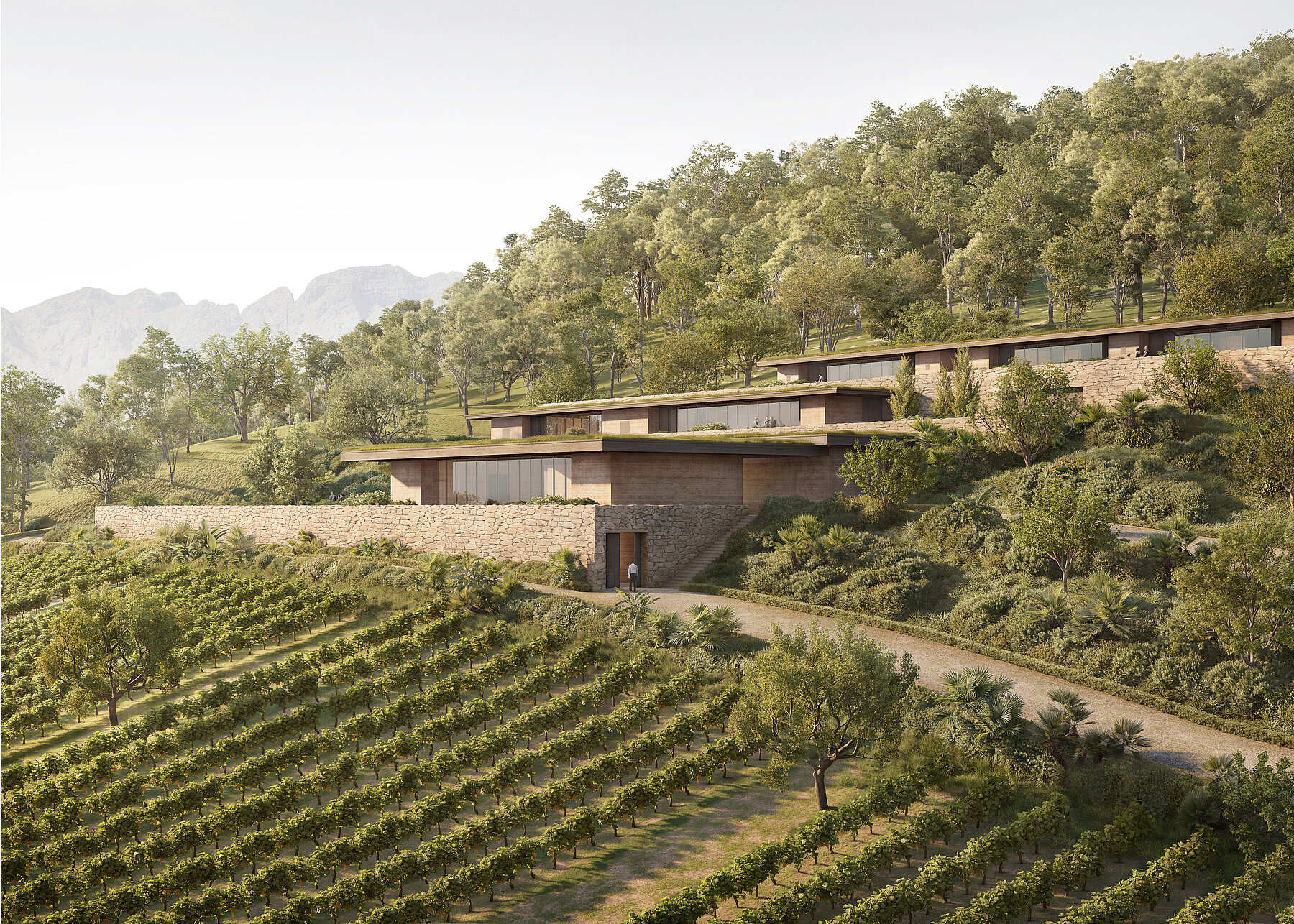
The exciting rendering of the new 4G winery above Franschoek (Copyright: Filippo Bolognese)
The lesser-known Bot River is also dynamic, where the "young guns" produce very individual wines. Here are some of the top wines that we often drank in the restaurant during our spectacular trip. Wineries like Crystallum, Momento, Damescene, Hogan, Savage, Thornton & Daughters and stars like Chris Alheit, are some of the country's greatest winemaking talents. Many of these "young savages" have only some of their own vineyards, some share a cellar and use their passion to bring the most exciting wines to the bottle. Most of the wines can be found at Hendrik Thomas' "Wein am Limit" if you are quick enough - because they often sell out in no time at all.
For many, the highlight of the trip comes at the very end at 4G Wine Estate. Founded in 2008 as a start-up, the estate produces premium wines that are among the most expensive in South Africa. A bottle of Grand Vin now costs a good €400, while the second wine is a real bargain at around €120. Ultimately, a strict barrel selection determines the first and second wines.
I have already reported in detail about 4G, its makers and the outstanding wines in WW 12/17, when the 2014 from 4G competed against the entire Premier Cru league in a spectacular blind tasting and won! The whole thing is reminiscent of the "Judgement of Paris" from 1976.
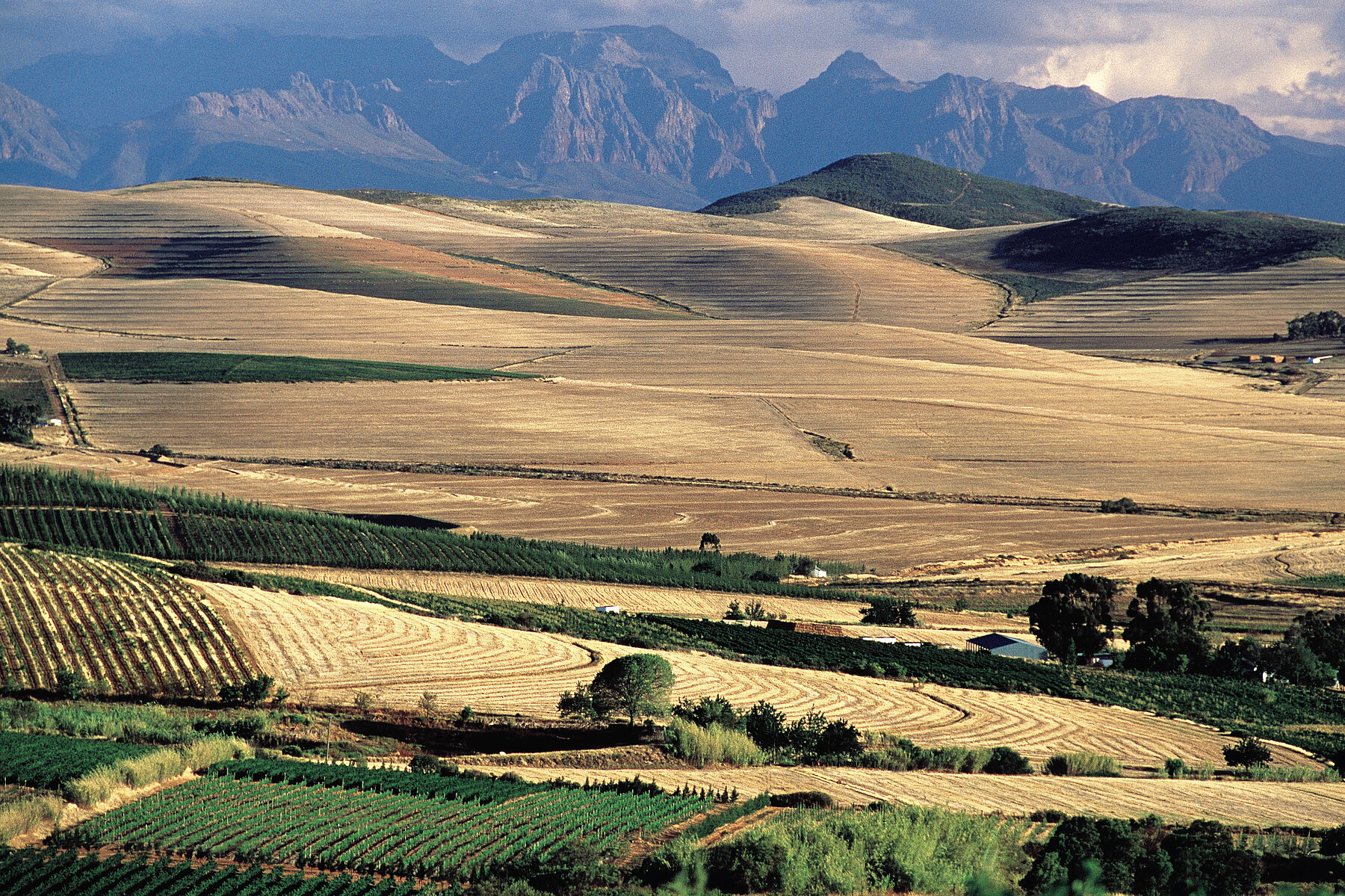
The Swartland ("Black Land") is located around 50 km north of Cape Town and is characterized by a Mediterranean climate: hot, dry summers, mild winters - ideal for old bush vines that provide concentrated aromas
That's why I called the article "The Judgement of Süllberg" at the time, as the blind tasting took place in the two-star restaurant in Süllberg. In WW 08/23, I also described and rated the largest vertical of the "G" to date and the second wine "Echo of G".
This time we were particularly excited. The boutique winery was the first group ever to welcome us to its new home in Franschoek. "Big news," Philipp G. Axt, the only remaining co-founder and CEO of what is now a “cult winery”, told me a few weeks before our trip. "We're building a new cellar and you'll be the first group to see it," he exulted. The new winery for 4G Wines is being built in the mountainous landscape of Franschhoek in a former horse stud. The site of the new winery is characterized by its unique hillside location with breathtaking views of the landscape. At an elevated point on the site, the new winery with its clear architectural language blends sensitively into the natural surroundings and yet is visible from afar as a new landmark of the wine region. The spectacular construction is due to start in 2026. Axt raised the money for this from investors in Germany and Switzerland. Axt had written to renowned architectural firms, including Pritzker Prize winner Shigeru Ban and David Chipperfield, whose design ultimately won. His expectations were not very high, but they were to be exceeded. He was even spoiled for choice among the designs submitted by renowned offices. It was a very special moment when Axt revealed the secret to our group of wine collectors and raised the curtain on the winning model.
What a fabulous milestone for this young winery, which began 15 years ago as a start-up with very limited investment.
In short: South Africa's Cape and surrounding area is still one of the most dynamic spots on earth and is flying high. It is only a matter of time before more icons make a name for themselves here.
There is hardly anything better than escaping the cold and gray winter to indulge all your senses. The Cape region is a hotspot for hedonists. There are other new restaurants and wine estates, not all of which we were able to visit due to time constraints, but which are certainly worth a mention. And one thing is certain: quality is rising dramatically across the board, and alongside the well established „classics", there is now a growing number of new top wines at an internationally high level.
Glenelly, Stellenbosch
The estate is characterized not only by its ingenious location and the diversity of its wines, but also by its famous owner. Madame May Lenquesaing, the former owner of the Bordeaux icon Pichon Comtesse, bought the estate in 2003 at the age of 78. The outstanding Lady May, a Bordeaux blend that focuses on elegance and finesse, is at the forefront.
Kanonkop, Stellenbosch
In Europe, this is often one of the first names mentioned when looking for a South African winery. Kanonkop is considered a "Pinotage" specialist, which brought high-quality and storable Pinotage to the market in the 1990s with the legendary cellar master Beyers Trute, the "King of Pinotage".
Since 2002, winemaker Abie Beeslaar has managed the wine cellar and the more than 100 hectares of vines. He has the privilege of looking after Pinotage bush vines that are over 50 years old.
Kanonkop recently celebrated its 50th anniversary. In addition to its top Pinotages, it is known for its long-lived Cabernet Sauvignons, especially the flagship wine "Paul Sauer". Kanonkop has been run by the fourth generation of the Sauer family, originally from Franconia, since 1904. The vines are between 30 and 70 years old and are only irrigated in emergencies ("dry farming").
Incidentally, the name Kanonkop goes back to "kopje", which means "little hill". Cannons were fired from here in the 17th century to alert the rural population to incoming ships so that they could offer their products there.
In addition to the well-made entry-level wines from the Kadette line, which can also be found in better supermarkets here, we tasted the Pinotages and Cabernets in particular. From the Kadette line, I liked the Cabernet Sauvignon best, which has a fine aroma of cassis and red berries and is linear in the mouth and exudes drinking animation.
Ernie Els Winery, Stellenbosch
The architecturally impressive wine estate was founded by the well-known South African golf star Ernie Els in 2000. Situated below the Helderberg, the wine estate impresses with a breathtaking view of Cape Town and Stellenbosch and has an excellent restaurant, which offers excellent meat and steak dishes in a relaxed bistro atmosphere.
Anyone who sits outside and dines with this magnificent view will not want to leave. The wines produced under the direction of long-time head winemaker Louis Strydom are expressive, complex and long-lasting. The motto "Passion for elegance" of golf pro Ernie Els applies not only to his sport, but also to his excellent wines, which often contain allusions to the golfer in their names, such as the quaffable entry-level wine "The Big Easy" or "Major Series".
The focus is on red wines, the flagship being the Ernie Els Signature, which we also tasted aged.
Taaibosch, Stellenbosch
Taaibosch is the resurrection of an old celebrated icon that was then known as "Cordoba Farm", but then almost fell into oblivion. The new owners, Lorraine and Pascal Oddo, immediately fell in love with the vineyard with its great potential and finally bought it in 2017.
They had the vision of bringing the winery back to the top in terms of quality here at the foot of the Helderberg. When they told the experienced winemaker and oenologist Schalk-Willem Joubert about their vision, they were able to win him over as a partner. Schalk-Willem had previously held a successful management position at Rupert & Rothschild for many years. He embarked on the Taaibosch adventure and has already bottled some great wines since then. There is only one red wine under the Taaibosch label; other wines are marketed under the Chant du Coq label, mostly from additional purchases.
The vineyard is idyllically situated below the Helderberg at around 400 meters above sea level, with the ocean ("False Bay") just 6 km away. The soils contain a high proportion of clay. The fact that no Taaibosch was produced in 2023 shows how quality-oriented the work here is. It was too rainy.
Rust-en-Vrede, Stellenbosch
Tucked away at the end of a long valley with beautiful wine estates and properties, the pretty white Cape Dutch cottage "Rest and Peace" awaits you in a shady garden. Rust en Vrede has been nestled in Stellenbosch's vineyards for more than 315 years, but it was only 32 years ago that the Engelbrecht family became the first wine producer to specialize exclusively in the production of red wines - primarily Shiraz, Cabernet Sauvignon and Merlot. The upmarket "Estate" and "Single Vineyard" series in particular are among the best reds in the country. The estate also owns a second line, which operates under the name Donkiesbaai.
The white cottage serves as Fabio Daniel's home for his fantastic, Italian-Brazilian inspired cuisine. One of his signature dishes is the "Doce de Queijo". It is a warm Parmesan dumpling with lime, coffee and caramel, served with Italian meringue and Parmesan snow. Fabio Daniel was born in Brazil, but his ancestors come from Abruzzo. You can taste his Mediterranean roots in every one of his dishes.
The difference to other top restaurants: less plate ikebana with lots of dots, more soul food with fresh flavors and products, of course interpreted and served in an elegant and modern way.
Mullineux, Swartland
The Swartland Wine Estate is one of the best wine estates in South Africa. After working abroad for several vintages, Andrea and Chris Mullineux decided to settle in the Swartland region of the Western Cape Winelands, firmly believing that the ancient granite and schist-based terroirs and old vineyards of this region have the potential to produce truly great wines. They started out in a garage on their Roundstone farm, where they still make their wines today.
Within a very short time, the winery established itself as one of South Africa's best-known wine brands, both locally and internationally. It now trades under the name Mullineux & Leeu Family Wines.
The exciting thing about tasting the single-vineyard trio is that all the wines are basically treated and matured in the same way, so that the differences in terroir really come to the fore.
I was most impressed by the white and red versions grown on slate.

Takuan von Arnim produces wonderful sparklings, Chardonnays and Pinot Noirs. He also runs a great restaurant with amazing views of the surrounding mountains.
Quoin Rock, Stellenbosch
The family-run Quoin Rock Wines winery is located high up on the Simonsberg in Stellenbosch and is a true showpiece of luxury and sophistication.
Even the entrance, with its stylized water cascade, is a feast for the eyes. The Ukrainian owner, Yulia, is an architect - and here she has fulfilled her dream. It offers elegant architecture, striking interior design and an excellent gastronomic experience in the prestigious "Gate" restaurant, which was better than ever this year with a 9-course menu that was perhaps a little too sumptuous for lunch.
Simelia, Wellington
The first vineyards were planted on Woestkloof Estate in the 1700s, when farmers discovered the ideal terrain for planting grapes for winemaking. The farm is situated on the gentle slopes of the Groenberg, where the interplay of terroir and climate creates the perfect and interesting partners for red grape varieties such as Syrah and Merlot. Woestkloof Estate has a wonderful old Syrah and Merlot stock, planted in the 1980s and 1990s respectively, producing fruit of the highest quality.
The vineyards are ideally situated on the gentle mountain slopes, where the grapes ripen in perfect conditions in the sun during the day, while the cooling mountain winds regulate the ripening process at night. The soil consists largely of decomposed granite with traces of table mountain sandstone, in which the vines have thrived with their deep roots for over thirty years.
The unique and exquisite nature of Groenberg's terroir is optimally utilized here to achieve the finest quality. The desire to produce wines that best characterize the Boland wine country is clearly evident, as is the conviction to grow only the grape varieties that are best suited to the area.
Damascene
Former Boekenhoutskloof cellar master Jean Smit launched a highly acclaimed project in Elgin in 2019 together with entrepreneur David Curl: Damascene Vineyards. Elgin is located on the route from Cape Town to Hermanus when traveling east over the Hottentot-Holland mountain range or via Overberg and is considered a cool climate. The brand new cellar, lined with an impressive row of concrete barrels, is located in Elaandskloof Valley. The altitude here is 700 meters above sea level.
The soil formations vary greatly: here you will find clay slate with fossils, clay, granite, stony mountainous areas, but also occasional limestone soil. We tasted a great range of amazing white (Chenin Blancs and Sémillon) and red wines including a high altitude (over 1000 m) Syrah from the Ceres Plateau. All wines are finesse and terroir driven.
Creation
At just 18 years old, Creation Wines is still more of a teenager, but what a teenager! Together with his wife Carolyn, who comes from a local wine family, Swiss-born Jean-Claude Martin has built up a real enogastronomic gem on what is now 40 hectares at the foot of the Babylon Toren mountain.
"We started with crêpes and baguettes," he smiles, looking back with obvious satisfaction. "There was nothing here," he adds. "Just the beautiful terroir", which can be enjoyed from the restaurant's terrace. On the mainly heavy clay soils, which are loosened up by Bokkeveld slate, the winemaker from Valais produces a whole phalanx of high-quality wines, which can be enjoyed in the adjoining restaurant with one of the fantastic "wine and food pairings".
His white and red Pinots in particular are among the best we tasted on site. The equipment from Germany and France is state of the art and so is his philosophy: spontaneous fermentation, whole bunch pressing, long maceration times and pneumatic bâtonnage are the cornerstones of his successful concept.
He also relies on environmentally friendly viticulture in the cool climate, even though the days above 30°C can be counted on one hand.
This makes Creation one of the pioneers of the small organic wine scene in the Cape, and once again Jean-Claude and his wife Carolyn took plenty of time for us over lunch. The tasting was crowned by the brand new, not yet released vintages of the top wines "Glen" and "Emma".
4G Wine Estate
4G was born from the bold vision of two wine lovers.
They had the audacious dream of creating a top-quality wine in South Africa that could compete with the best wines in the world. They had neither a vineyard nor the financial means, but they had plenty of creative ideas. Together with the late wine pioneer Prof. Denis Dubourdieu and his business partner Dr. Valérie Lavigne, they caused a sensation with their very first vintages. Numerous international comparative tastings showed that ‘G.’ belongs in the premier league of the wine world.
This was also the case at the 2017 tasting in the hotel's two-star restaurant in Süllberg, where the unknown ‘underdog’ challenged the entire Premier Cru elite and finished in the top 3. To counter the possible objection that an open, fruity charmer often performs better than a closed, far too young Bordeaux, I made it a condition at the time that a highly rated non-Bordeaux wine be included in the blind tasting. The choice fell on Pingus, highly decorated with 100 Parker points. Anyone who now thinks that it must have finished at the top because of its opulence and concentration will be surprised: it came third from last.
In 2022, all the vintages ever produced of the now coveted cult wine were brought to the table at another sensational tasting, which also showed how well the wines mature. At a blind tasting last fall in London with experienced Masters of Wine and Master Sommeliers, the 2018 G. from the cult winery 4G was able to leave the 100 Parker points elite of this vintage such as Lafite, Margaux, Ausone, Pingus and Sine Qua Non behind and emerge as the winner of the comparison. As part of my culinary wine tour, CEO Philipp G. Axt welcomed us to his new premises in Franschoek, where he exclusively showed us the remarkable designs for the cellar construction and presented us with some great vintages of "G" and "Echo of G" in an enjoyable afternoon. A great tasting. And the spectacular new building will be a crazy milestone in the young history of this South African jewel.
Eben Sadie Family Wines
Eben Sadie is the undisputed king of the Swartland and perhaps the best winemaker in South Africa at the moment. There has been a lot going on in the Swartland for years, where the star of the scene Eben Sadie produces world-class wines and rarely receives visitors. He took more than three eventful hours of his time for us, because he has a very clear and sustainable vision of winemaking.
His top wines are the long since famous Columella, his Palladius and the fantastic Skerpioen - I rated all three wines with 19/20 points, which stands for world class and thus provides the answer as to whether there are already wines at the highest level in South Africa. Incidentally, the new winery at Rotsvas Farm is an architectural masterpiece that reflects the great pioneering spirit of the Sadie family. The production area is modern and functional, while warm wooden elements and a well thought-out design create an inviting atmosphere in the rest of the building.
Sustainability is a top priority for the Sadie family in all areas: A modern water treatment plant and a solar system ensure environmentally friendly production. The new winery is a place that harmonizes nature, tradition and innovation - perfect for the next generation of Sadie Family Wines.
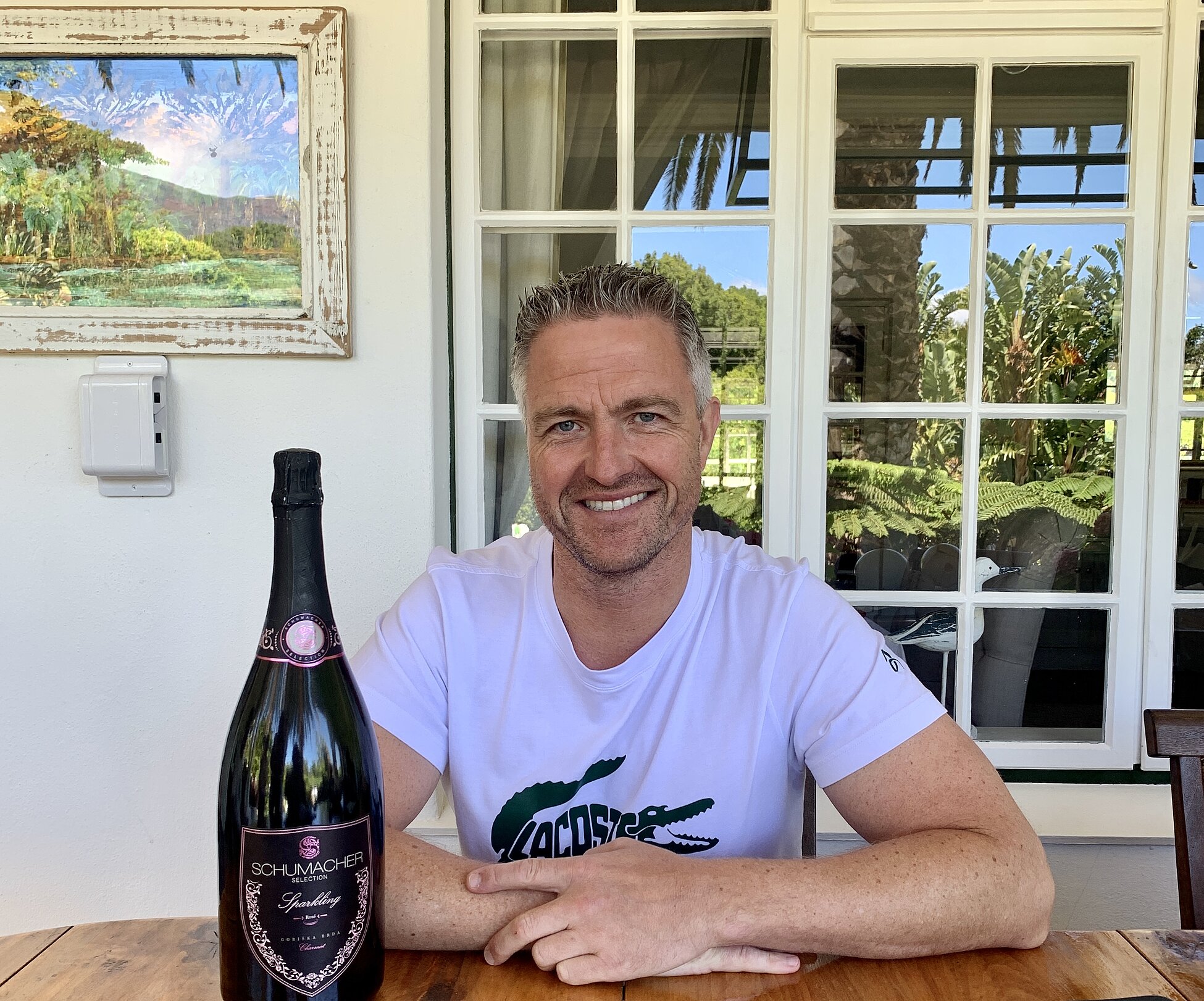
Visiting Villa Coloniale Schumacher – with Ralf Schumacher, who makes wines in Slovenia – the sparkling wine bears a striking resemblance to a well-known luxury brand from Champagne.
Klein Constantia
Here too, the Dutch governor Simon van der Stel had a hand in the founding of this mythical wine estate: he planted 100,000 vines near the village of Constantia back in 1685, and in 1716 the farm was divided into Groot and Klein Constantia.
Today, the relaunch of Vin de Constance and a broad portfolio on 140 hectares are building on old successes - after all, Napoleon was already a lover of this exquisite dessert wine. With Hans Astrom and his young winemaker Matthew Day, Klein Constantia is focusing on a sustainable approach that uses solar energy and a lot of recycling. 70% of the vines are Sauvignon Blanc, with red making up only 10%. In 2012, the company merged with the Anwilka winery in Stellenbosch.
The wines are said to be free from additives and only slightly sulphurized.
Selected lunch and dinner wines
The vast majority of the restaurants I selected not only offered sophisticated menus, but also well-stocked wine lists. This allowed us to try wines from wineries that we hadn't visited this year or that simply piqued our curiosity. From old to young, from superstars to unknowns, everything was there. I didn't take notes on all the wines, as the days were long and intense. We drank pretty much everything from Chris Alheit, especially his mineral-rich Chenin Blanc "Cartology" and his excitingly intense and exotic field blend "Hemelrand Vine Garden", as well as Crystallum, Hamilton Russel, Restless River, Eben Sadie, Oldenburg, Storm and a few others. One of the highlights was the 1990 Cabernet Sauvignon from Kanonkop and the private tasting of the two exceptional vintages 2018 and 2017 from 4G.
➜ As a subscriber, you can find the tasting notes of all wines together with older vintages in our brand new database.
